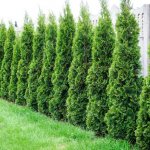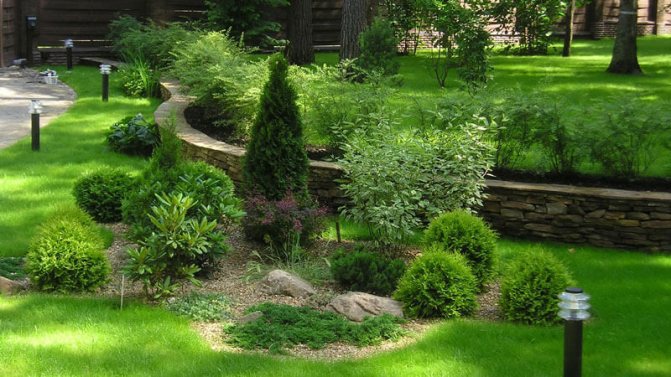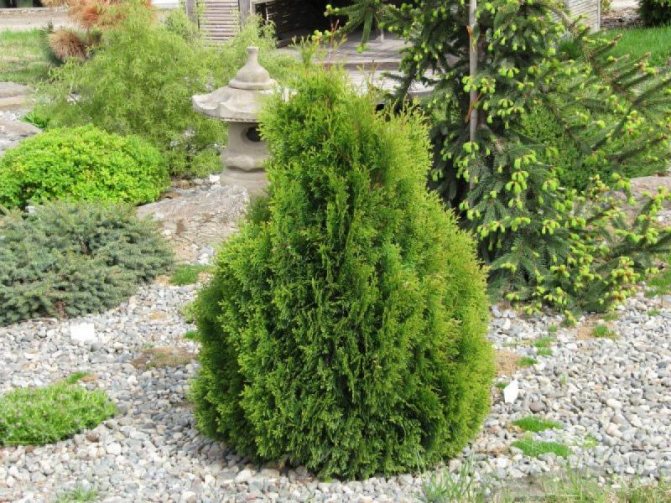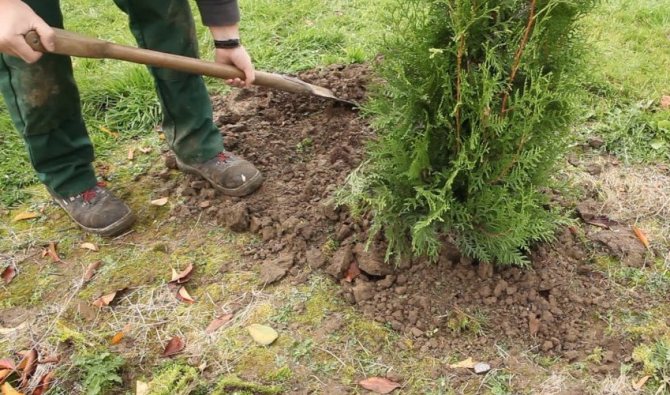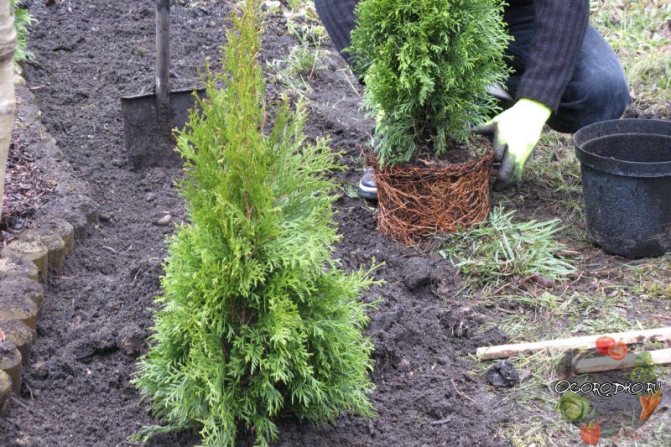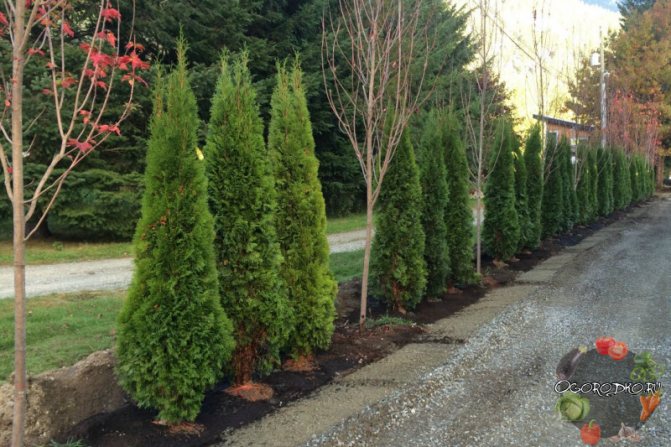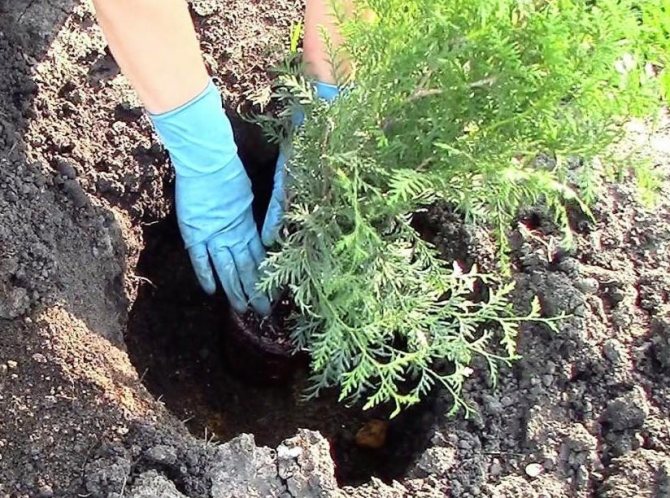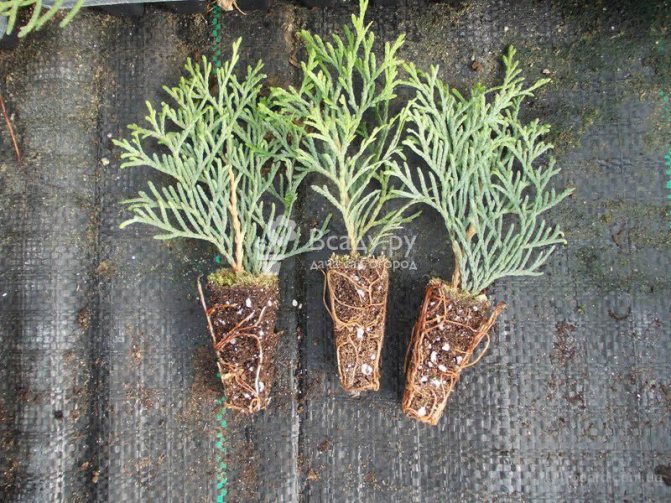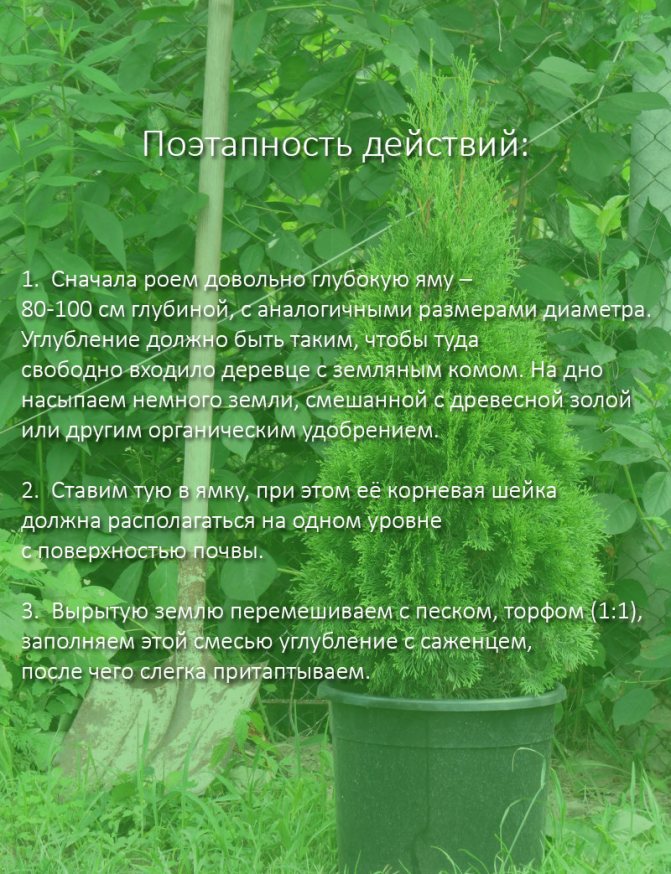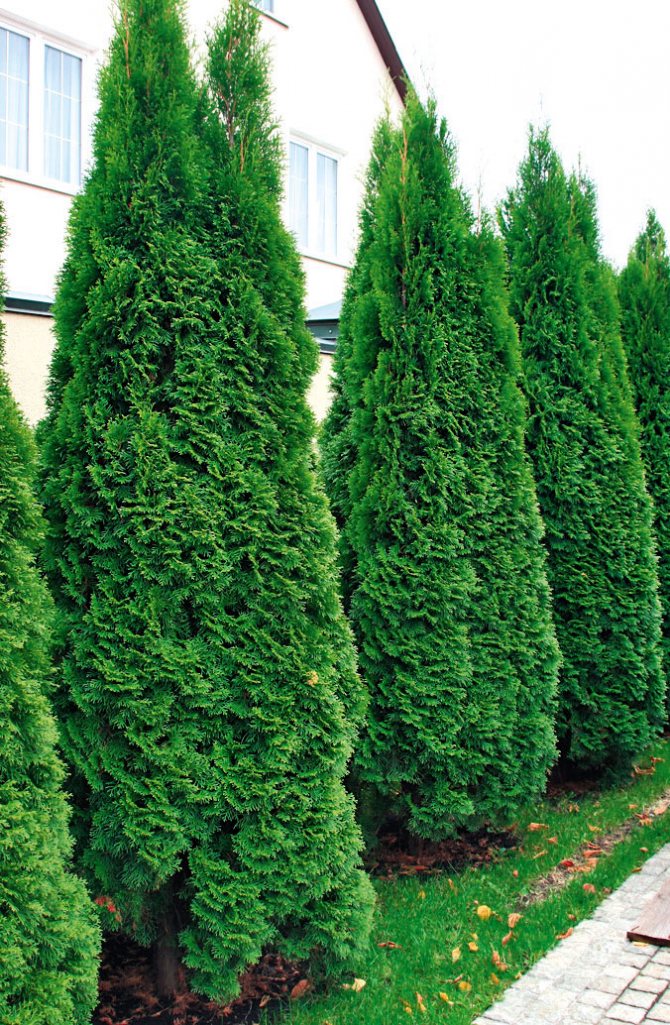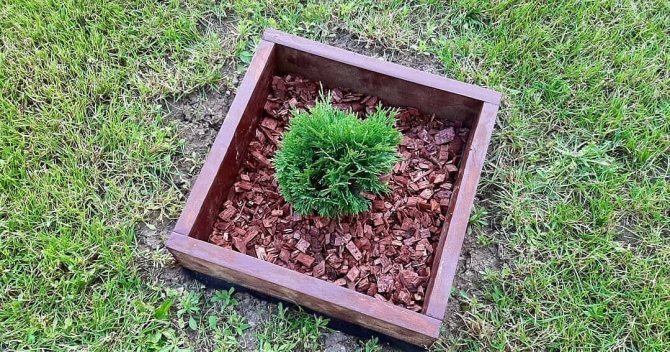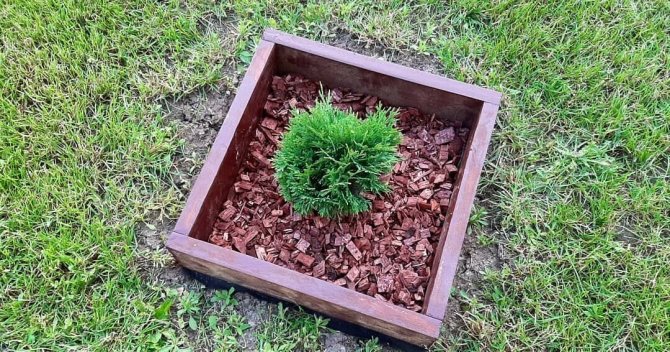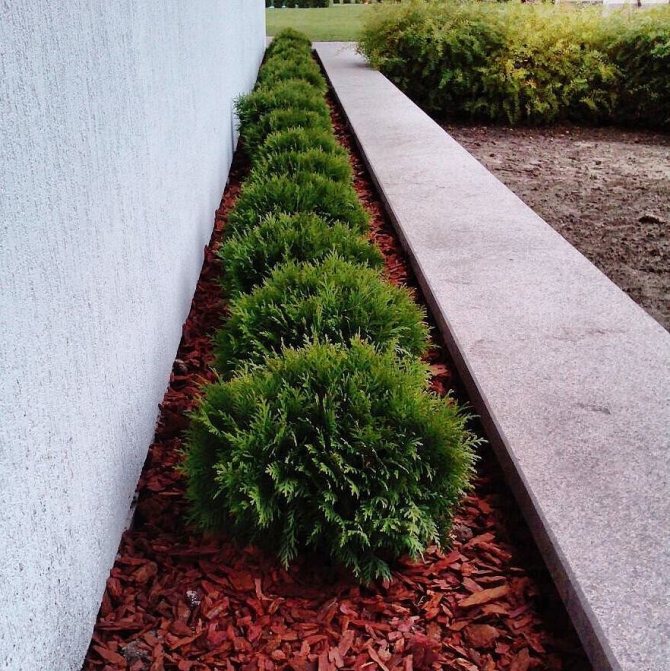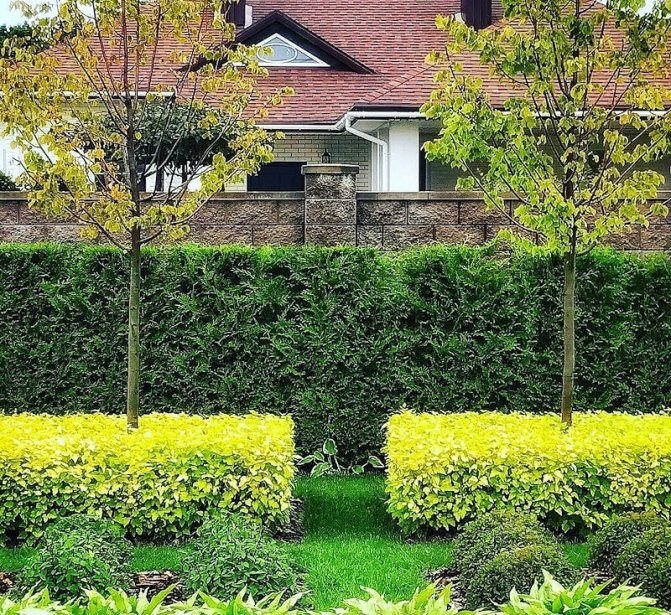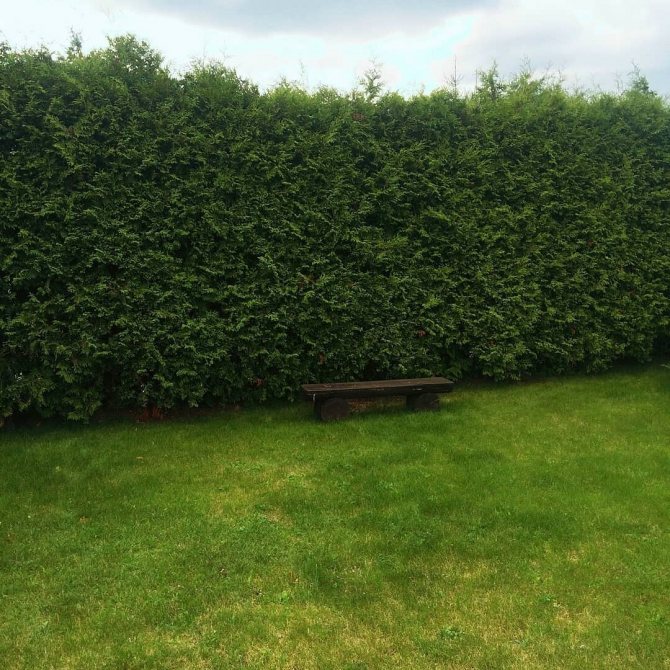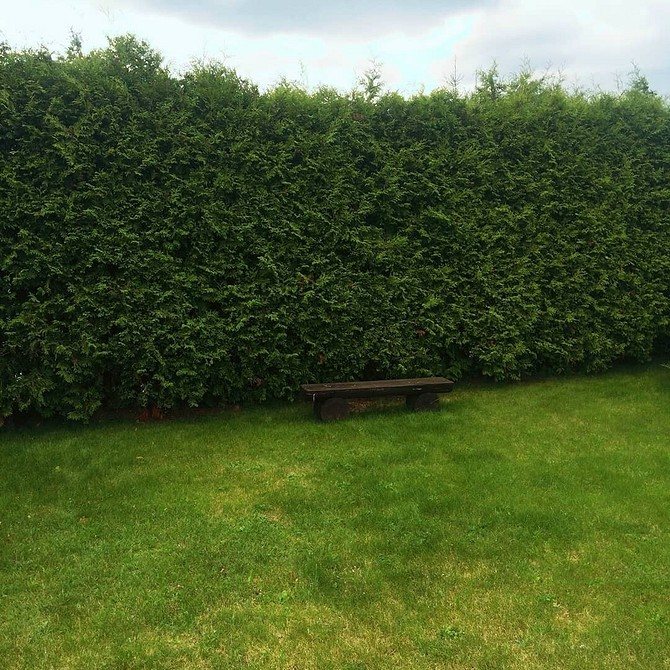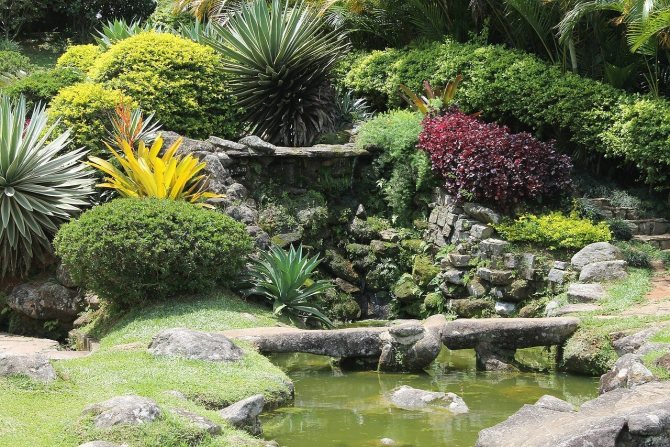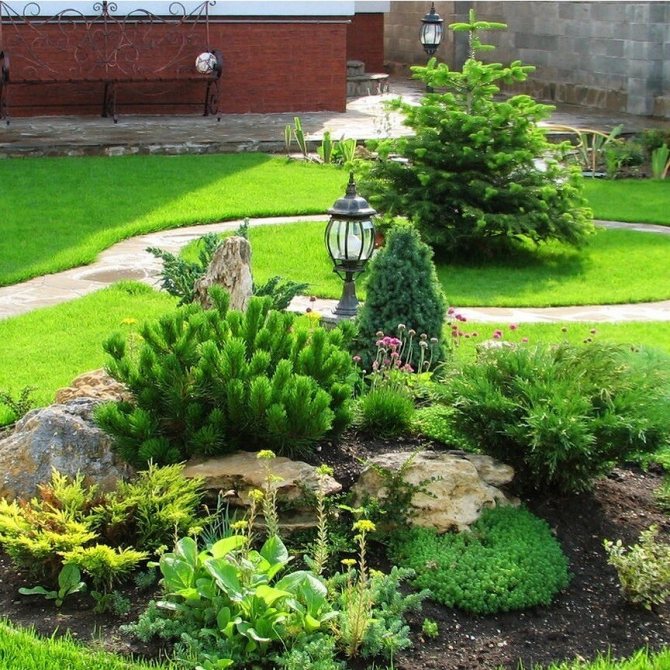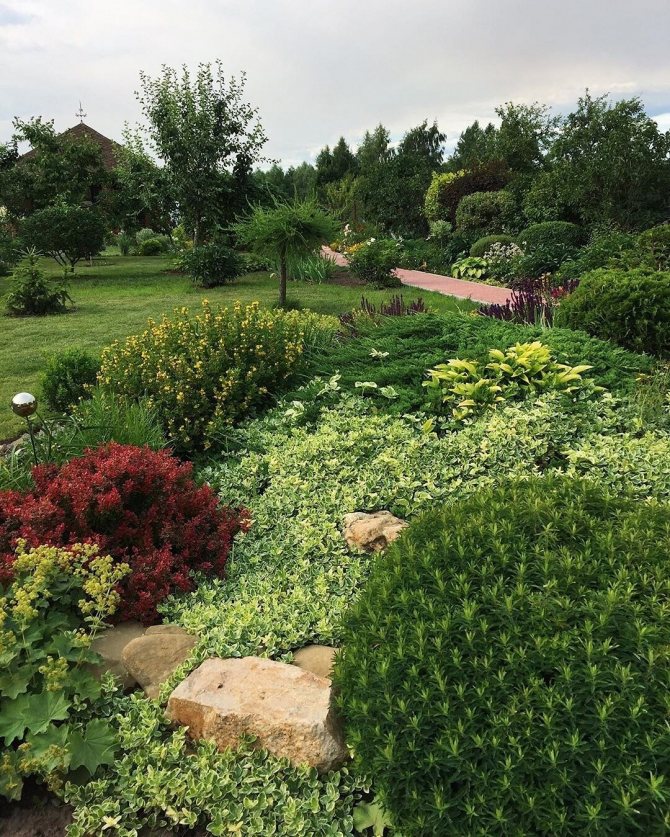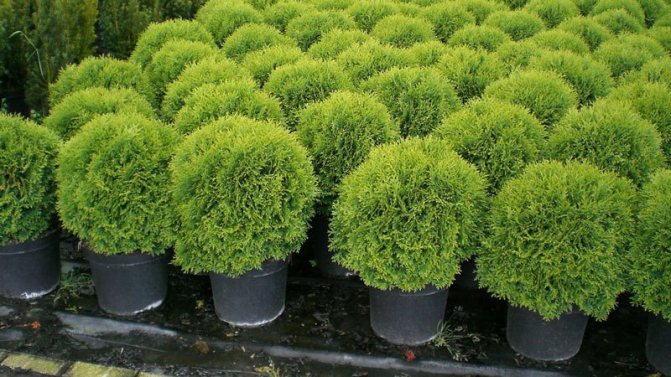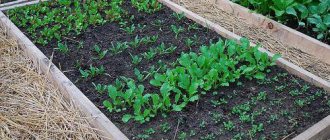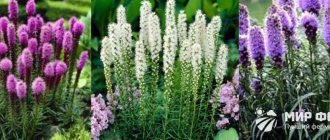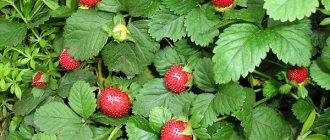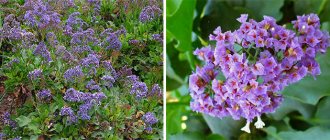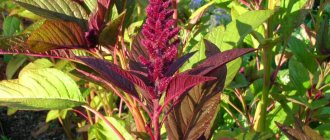Thuja is a beautiful evergreen plant of the Cypress family. Appreciated for decorativeness, grace, unpretentiousness. Among other conifers, it stands out for its soft, unobtrusive aroma and rich bright green color.
She so naturally blended into the landscapes of our gardens, parks, alleys that it’s hard to believe - this beautiful and delicate plant does not grow in natural conditions on the territory of Russia. The homeland of thuja is North America (hence the other name - "Cypress of the North"), but thanks to its attractiveness and ability to adapt to various climatic conditions, it has spread throughout the world. Under natural conditions, these conifers grow more than 20 m in height. how
domestic, ornamental thuja plants rarely exceed 10 m in height.
Thuja: planting and care outdoors in different parts of the country
Once, having visited America in my youth, I saw a tree of extraordinary beauty. Somehow it reminded me of our Russian Christmas tree or pine. I asked passers-by and found out that this tree is called thuja.
But what was my surprise when I learned that the thuja was brought to Russia many years ago. Now it is easy to see thuja in our latitudes, but in my time it was a rarity.
From that moment on, I dreamed of making a decorative fence in the garden from thujas planted in a row. After reading on the forums about planting and growing methods in our latitudes, I finally decided to plant a miracle tree in my garden.
Twenty years have passed, my youth is gone, but in my garden there is a decorative fence, which I have dreamed of since my trip to America. How I achieved such success, I will tell you in the article.

Fertilizing and mulching
Thuja, like many ornamental plants, needs regular feeding. It reacts to fertilization with faster growth (although thuja is one of the slowest growing crops), splendor, brilliance and bright color of the needles. Often it is not required to fertilize the plants, 1-2 times are enough - at the beginning of the season or in summer. In addition to traditional compost, you can use special mineral fertilizers for conifers.


Fertilizing thuja is economically profitable: a hundred-gram sachet of Fertika complex mineral fertilizer for feeding conifers in summer costs 90-100 rubles
Experienced summer residents recommend the universal product "Fertika" for Finnish evergreens, they are introduced into the soil when loosening - they are scattered around the trunk and carefully dug together with the top layer of soil. Dosage - 35-40 g per 1m² of soil. The summer version is dissolved in water and used during watering.
The trunk circle needs additional cleaning and loosening. To protect against weeds, retain moisture and increase fertility, the area around the trunk is mulched with compost or sawdust. For decorative purposes, the soil is covered with colored chips or nut shells.
What is thuja and what is it eaten with
Before growing, I realized that first I need to learn as much as possible about this type of plant.
Thuja is a gymnosperm plant. Refers to the same species with pines and Christmas trees (it was not for nothing that I found something in common between them). The truth is, there is one difference. The needles of Russian conifers are tough and can easily be pricked.
In thuja, the structure of the needle is different. She's soft.From afar, you might even think that the plant is deciduous. But the paradox is that it is evergreen.
Another surprising fact for me was that the plant does not care where to live. It is perfectly adapted to city life. In big cities, it plays the role of not only a beautiful decor, but also helps in landscaping the streets.
Possesses medicinal properties. Oil perfectly cures skin diseases. And taking a bath with the aroma of thuja is a real pleasure. Nervousness disappears, stress goes away.
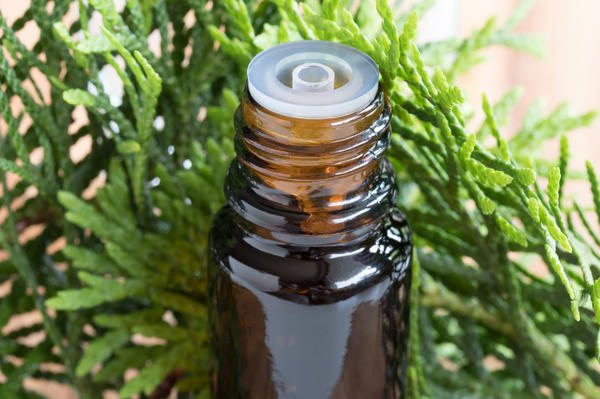

There are many types of thuja, but in Russia the western thuja takes root best of all, which perfectly withstands the harsh Russian winters. She does not have beautiful multi-colored flowers, but she perfectly plays the role of a hedge.
Thuja take root best in the center of Russia. In the Black Sea area, caring for thujas is more difficult, since the scorching sun has a bad effect on the condition of the plant. In the northern regions, thuja takes root well in greenhouses.
Photo of thuja western Smaragd in landscape design
If you still doubt that this tree is what you need, then we offer you a selection of photos of thuja Smaragd in landscape design.
Thuja planting
I decided to plant thuja with seeds, which I did not regret in the future. I learned that this method helps the plant adapt to the local soil, which makes the plant hardy in the future. Each cone contains two seeds. In the fall, they mature and are ready to breed. The seedling will germinate for five years.
I chose a sunny place, thinking that the plant is southern. I planted it in the spring to give the seed as much heat as possible. I planted it to a depth of 5 centimeters. After that I covered everything with coniferous sawdust. The sprout sprouted quickly enough.
I decided to weed. She touched a tender sprout and destroyed it. It was my first failure, but I didn't stop. The next time I loosened the soil much more carefully, adding slurry diluted with water in a ratio of 1:20.
If you don't like the seed growing method, there are other methods.
Recently I tried the method of propagation by shoots. I cut off cuttings from my young thujas (each was two or three years old), treated with heteroauxin. For the best effect, I used a mixture of peat and turf and planted it two centimeters deep.
The method of growing seedlings categorically did not suit me. Convenience was that the result was faster. But for successful germination, it was required to grow the tree in greenhouses so that the sun did not damage the plant, and there was sufficient moisture. Since I was making a hedge, I didn't want to waste time planting a tree in a greenhouse.
You can learn more about planting a thuja from the video tutorial:
When my first thuja took root, I began to think about how to properly care for an ornamental plant. I began to read various literature and surf the forums on the Internet. Over the years, I have come to one single system of thuja care.
The first thing that every lover of ornamental plants needs to understand is that they did not get their neat look from nature. You will have to follow the shape, otherwise a huge number of cones will appear on the thuja, it will grow in all directions.
Thuja responds well to frequent watering. It blooms pleasantly during heavy rains. Despite the fact that the plant is shady, in partial shade and in the sun it feels better.
At first, the humidity refused to be checked, for which she lost several thujas. The humidity should be optimal.
Young trees should not be fertilized all the time. They start to grow rapidly, which leads to an ugly shape that is difficult to fix. After the end of the gardening season, I cut off the extra branches.
At first, I had a very distant idea of where my hedge would be located, and I didn't really believe that something would work out. I planted it in the first place that came across, after which I realized that the tree was not in its place.I decided to check how the plant will survive the "move". To my surprise, everything went well. So don't be afraid to experiment.
Tui are afraid of the huge amount of sunlight. The winter sun can burn an ornamental plant, which no gardener wants. Therefore, I tied the crowns of the trees.
I fed a little when the plants became strong and hardy. Nitrogen fertilizers are my favorites. On my poor soil, phosphate fertilizers did their job well.
Preparing thuja for winter
Despite their endurance, thujas need additional shelter for the winter. Preparation begins in the fall:
- Watering, feeding, pruning stops.
- The branches are pulled together with an elastic cord so that they do not break from the wind or the weight of the snow.
- High hilling and mulching are carried out.
- Dwarf thuja are covered with cardboard or non-woven fabric.
- In the regions of Siberia and the Urals, mini-greenhouses are being built for all thujas.
- With the onset of spring, greenhouses and cardboard can be replaced with lutrasil so that the bright sun does not burn the branches of the tree.
- The shelter is removed only after the onset of stable heat.
Thuja is a very beautiful ornamental plant that attracts with its graceful form and unobtrusive fresh aroma of the forest. The ability to ionize the air makes this ephedra also a very useful plant. Knowing some of the features of growing thuja, you can create a unique evergreen corner that pleases the eye and brings a good mood all year round.
Frost-resistant varieties
Frost-resistant thuja, as a rule, belong to the western thuja species (Thuja occidentalis), which is very widespread in ornamental gardening. Suffice it to say that on its basis, breeders have bred over 120 varieties. Now we will look at the most resistant to low temperatures.
Thuja 'Brabant' - a tree reaching a height of 4 meters. The crown has the form of a column 1.5 meters in diameter. The plant is covered with green needles, which take on a brown hue in winter. Trees of this variety grow quickly: during the year they become 30 cm taller and 15 cm wider. A very unpretentious plant that tolerates periodic cutting well. "Brabant" feels comfortable in a well-lit place, but a small shadow will not hurt it either. Better to protect it from the draft. Flowering occurs in May. After that, ovoid bumps appear on it. It would be best to plant the "Brabant" in black soil.
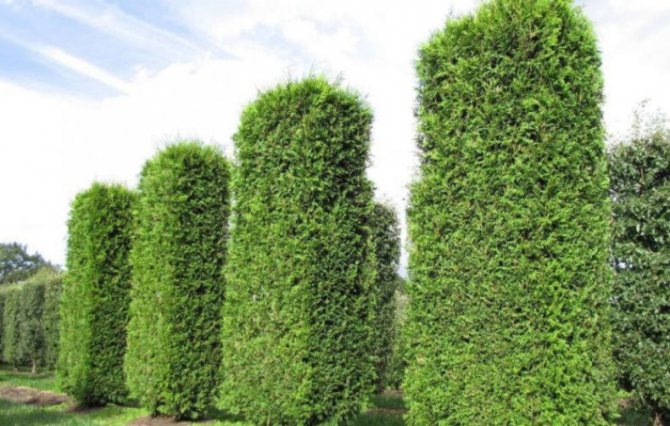

Brabant Tuyu 'Smaragd' characterized by a height of up to 4.5 meters, a crown in the form of a cone, a dense structure of branches. The needles are dark green in color, which persists even in winter. This tree does not grow rapidly, it loves regular irrigation. Most often "Smaragd" is used to mark the territory of a land plot. Due to the slow growth in height and breadth, the tree does not need to be cut frequently.
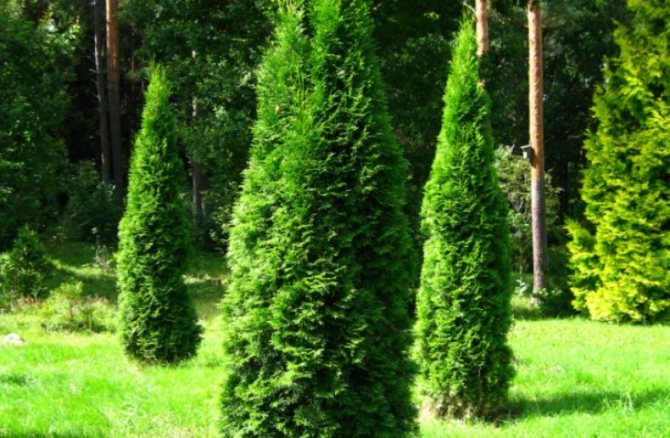

Smaragd Columna can be recognized by a height of 6 meters and a diameter of 1.5 meters. The crown is distinguished by its density, compactness, horizontal shoots, scaly needles of a dark green color, which remains so all winter. Columna can grow 20 cm per year. Its advantage is the absence of requirements for soil and air temperature, since this variety is very frost-resistant. The plant is used to imitate Crimean cypress trees, creating an atmosphere of Mediterranean style. Requires average soil moisture and moderate fertility. If drought prevails, the tree may die. It takes root well in a semi-shady area.
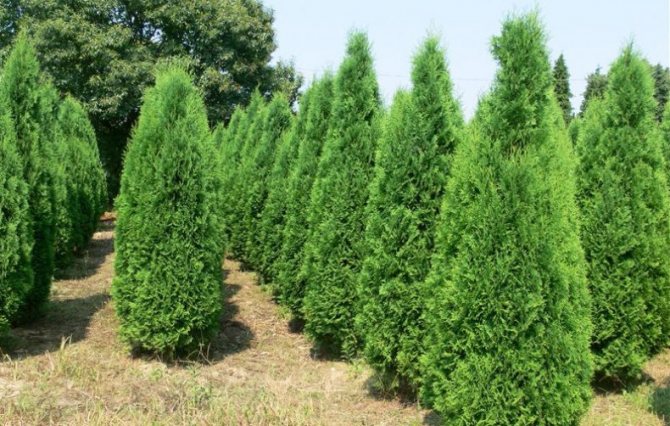

Columna Tuyu Holmstrup originally from Denmark can be determined by the height of the trunk of 3 meters and the meter diameter of the crown, which looks like a column. The needles are distinguished by their particularly dense curliness and year-round color fastness.The most suitable variety for busy people, because it does not require much maintenance. During the year "Holmstrup" grows a maximum of 12 cm in height and 4 cm in breadth. Holmstrup can reach its maximum height 40 years after planting in the ground. Survives in dry or excessively humid conditions, sunny and shady areas.
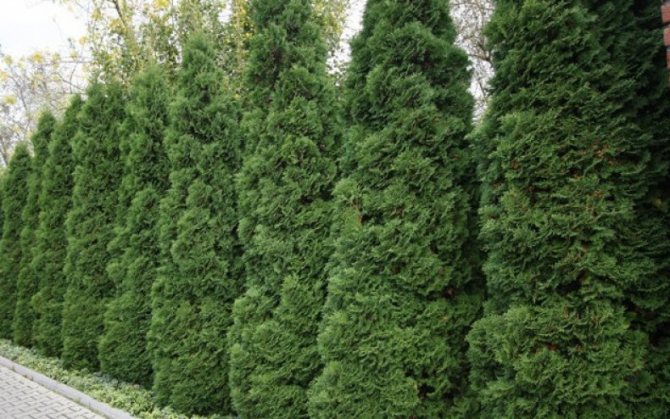

Butlmstrur 'Fastigiata' characterized by the shape of the column, shoots pressed to the center of the tree, light green fluffy spare needles, height about 6 meters, habitat in the middle lane. It grows up to 30 cm annually. Fastigiata continues to grow well after a haircut, without changing color during winter. Differs in frost resistance. It resembles a cypress in shape. Cones of this variety are barely noticeable, brown in color.
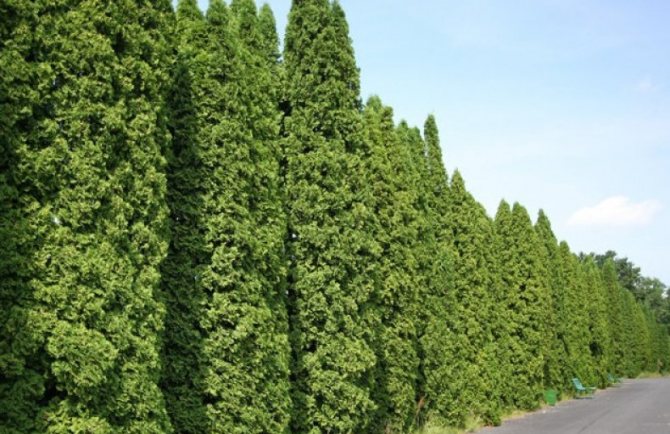

Fastigiata ‘Sunkist’ can be recognized by a height of about 5 meters and a conical crown with a diameter of 2 meters, large and dense, with dense ruffled branches. The color of the needles is golden yellow, becoming bronze during aging. In 10 years it can grow by 2 meters. It is characterized by resistance to subzero temperatures, photophilousness. Suitable for both group planting and single planting.
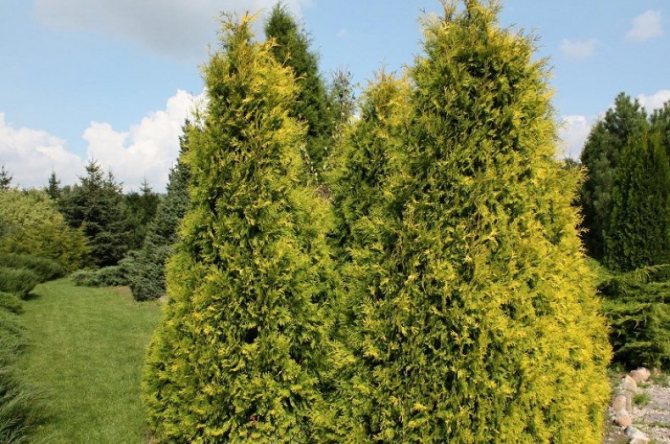

Sunkist Tuya 'Wagneri' reaches a height of 3 meters and a width of 1.5 meters. The crown is ovoid, dense, gray-green with a copper tint. For the variety, fertile, constantly moist soil and an open, light area are important. "Wagneri" is rarely trimmed, as it itself retains the original shape of the crown.
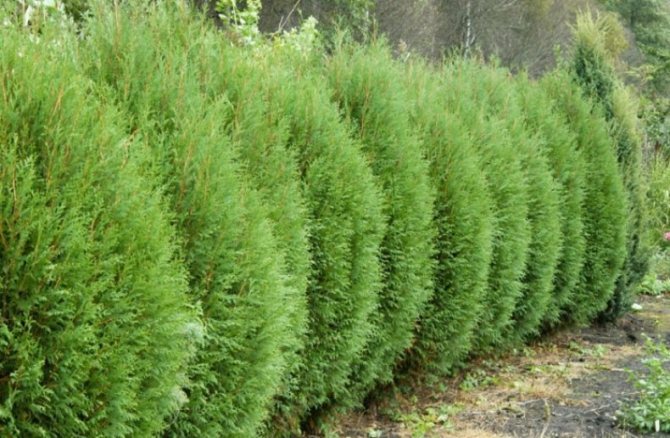

Wagneri ‘Cloth of Gold’ - thuja in the form of a low (up to 2 meters) shrub, the width of which is 1.5 meters. Its crown has the form of an ellipse or cone, which consists of delicate needles of a needle-like and scaly type with a lemon or copper color. Clot of Gold will not grow quickly. He needs high-quality drainage, moderately fertile soil, the presence of alkali in it. May die from excess water. Loves sun rays or partial shade.
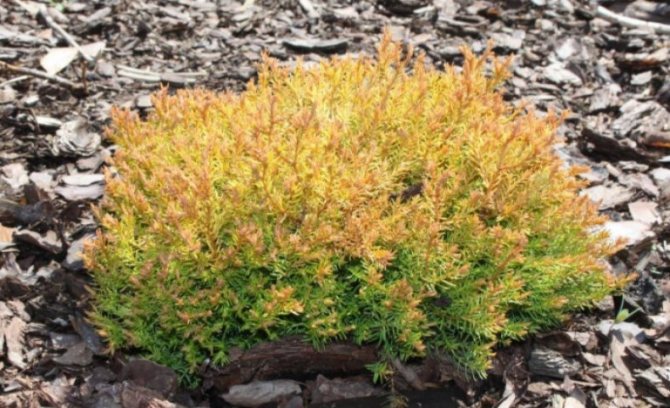

Cloth of Gold
Breeding methods and cultivation features
The shrub is grown at home, and only then planted in open ground in the garden.
You can use a simple and easier way - to purchase a ready-made seedling, which must be planted immediately after purchase. But self-cultivation is much more interesting.
So, you can grow thuja from a seed or from a selected cuttings. Both methods are worthy of detailed consideration.
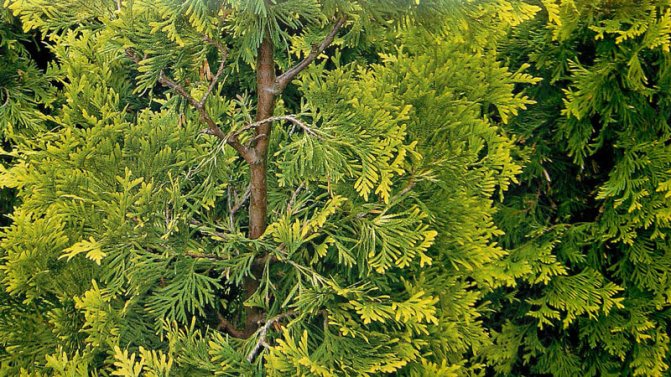

Growing a seedling from seed
If you are new to gardening, then the question is, how to grow thuja from seeds, should be considered in more detail. The seeds of the presented plant can be purchased at a specialized store or you can get it yourself.
Thuja has woody cones, from which seeds are extracted from September to December.
Cones are placed in a ventilated place under diffused light. After a while, they open, and you can safely remove the seeds.
Further growing thuja from seeds at home happens as follows:
1. The first method of planting seeds involves using a regular flower pot and soil mixed with peat and humus.
Previously, the seeds are kept for a day in a damp cloth. You should not plant the seeds deeply, just sprinkle them with earth or sawdust on top.
As necessary, the planted seeds are watered (with drying out of the soil) and kept under diffused light. Sprouts should be planted with warming up the soil in the garden in the spring.
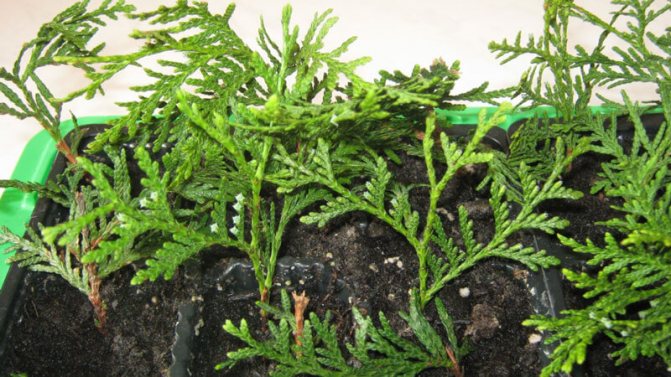

2. The second method of planting seeds gives a germination rate of about 90%. Here, in September, you should remove the seeds from the cones and put them in a bag, which must be stored in a cool place until it snows.
As soon as the snow completely covers the earth's surface, the seeds are buried in snowdrifts and kept there until spring.In the spring, it is already possible to plant the preserved thuja seeds also shallowly into the soil of the garden plot at a distance of 10 cm. It is important to water the garden abundantly.
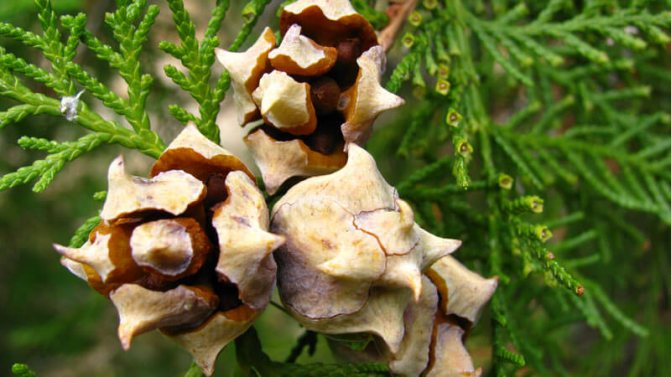

Thus, sprouts grow for 3 years, taking care of them properly - removing weeds and watering regularly as the soil dries. In the fourth spring, you can plant the sprouts in a permanent place.
From the above, it becomes clear that such a cultivation takes a long time.
Therefore, gardeners resort to the second method of self-growing seedlings using cuttings.
Growing a seedling from a twig
How to grow thuja from a twig, if there is no plant presented on your garden plot?
In April, when the buds are ripe on the branches of the plants, visit a fruit tree nursery or visit your neighbors whose garden is decorated with this unique and interesting shrub. Ask to cut a lignified stalk about 40 cm in size.
Then you will need to perform the following actions:
- Divide the stalk yourself into 2-4 specimens so that each of them has a part of the mother bark.
- The resulting branches must be treated with any solution that stimulates rooting, and left for 12 hours to process.
- Prepare the soil in your garden - add some peat and sand to the soil.
- Plant the cuttings into the ground to a depth of no more than 3 cm.
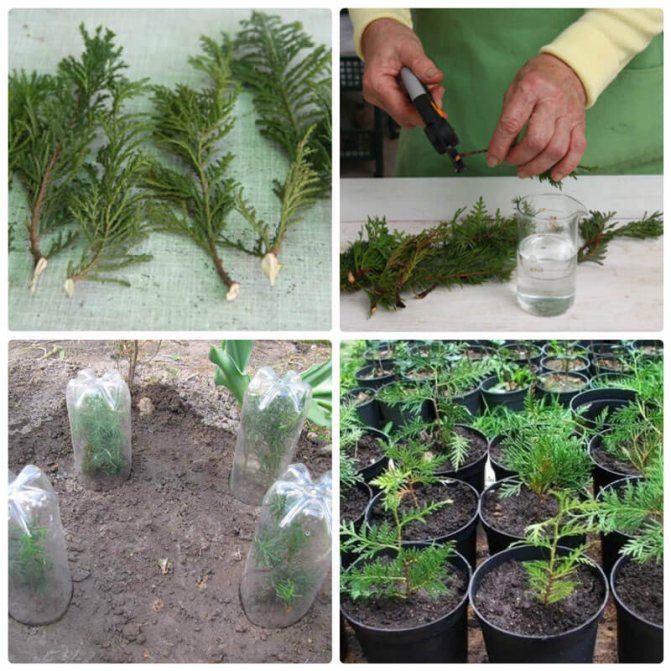

- The soil should be well moistened, but also do not forget about spraying - this is an important condition in the presented method of growing a seedling. When the cuttings are rooted, watering is significantly reduced.
- For the winter, new mini-shrubs are covered with polyethylene if the planting took place in a region with a harsh climate. In other cases, it will be enough to cover with fallen leaves or spruce branches.
Similar thuja propagation by cuttings can be done at home. Branches are planted in a container with soil and covered with a greenhouse - such an action will lead to faster growth.
Just do not forget about the appropriate daily airing, watering and spraying until the cuttings are completely rooted.
How to propagate and grow thuja, video:
When is the best time to plant
Tui are mainly planted in the spring, as this gives them a better chance of taking root over the summer and being frost-hardy. If you planted a seedling in the fall, you should take care of sheltering it for the winter.
It is best to buy plants in the climate zone in which you plan to grow thuja. Thus, you will be dealing with an acclimatized plant that will suffer less during transplantation to a new place.
It is important to choose a variety that will be most comfortable in your climate. This will allow the plant to overwinter safely.
Self-forming bonsai
Surprisingly, some growers give the bush-like thuja the shape of a bonsai tree. This is not easy to do. It is not enough just to pinch and cut the plant.
To form a bonsai, it is necessary to give the shrub an appropriate shape, subjecting its branches to a forced change in the direction of growth, slightly breaking them at the same time. The curved branch is fixed in a new direction and all branches are cut off.
After a while, the shrub will begin to form into a bonsai tree, where you should monitor the formation of the crown, constantly pruning.
Pay attention to this material - Barberry: planting and care, useful properties.
Thuja: varieties, planting in open ground, proper care
Thuja is a bright representative of the Cypress conifers. It is a widespread, beautiful, evergreen plant. Due to its excellent decorative qualities, it has received the name "royal tree". Many gardeners decorate their backyards with this plant, and it is also very popular with landscape designers.
This plant is called the "tree of life" because of its medicinal properties.In addition to the fact that many medicines for various purposes are made from it, the aroma of this tree itself is also healing. Therefore, a walk in the garden where thuja grows has a beneficial effect on the body.
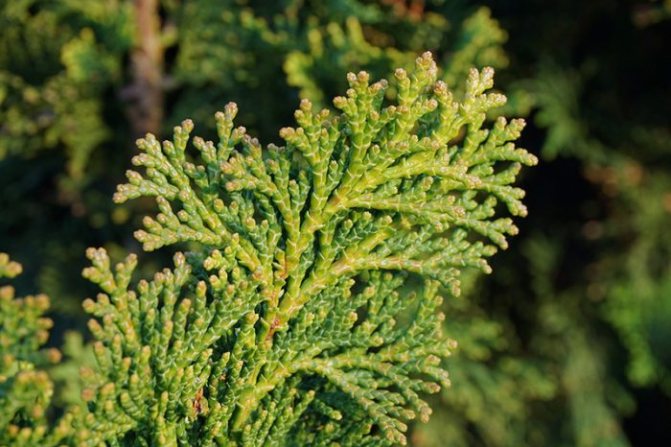

A guest from North America (widespread in East Asia), thuja has taken root well in the climatic conditions of the middle zone, due to its unpretentiousness, some species can withstand even severe frosts. These plants are ideal for arranging hedges and are often used to create beautiful landscape compositions. To provide the necessary care for thuja outdoors, it does not take a lot of time and effort.
Thuja pests and diseases
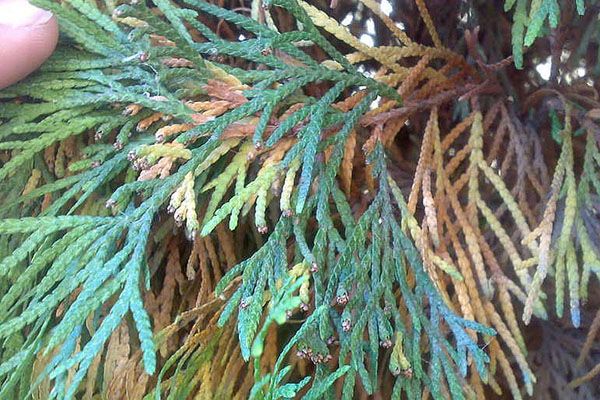

Thuja, as an ornamental plant, is often attacked by insects and some diseases. Here are the most common ones:
Perhaps these are all diseases of thuja Smaragd.
Description of thuja
These evergreens are shrubs or trees. Several species are common in nature. Under natural conditions, there are specimens up to 70 m high and a crown diameter of up to 6 m. Ornamental varieties in the gardens of the middle zone have a maximum height of up to 10 m, some up to 20 m.The crown diameter reaches 2.5 m.
Thuja belongs to the genus gymnosperms of conifers. Flat seeds with two wings are 1-2 pcs in oblong or oval scaly cones. Ripen by autumn. Those containing seed are in the middle of the crown, in those that grow closer to the top of the thuja, there are no seeds.
Leaves in young plants are needle-like, soft, light green, and in adults, they are dark green, scaly, lighter on the underside than on the upper. Some varieties develop a brownish tint in winter. They are soft to the touch, almost do not prick.
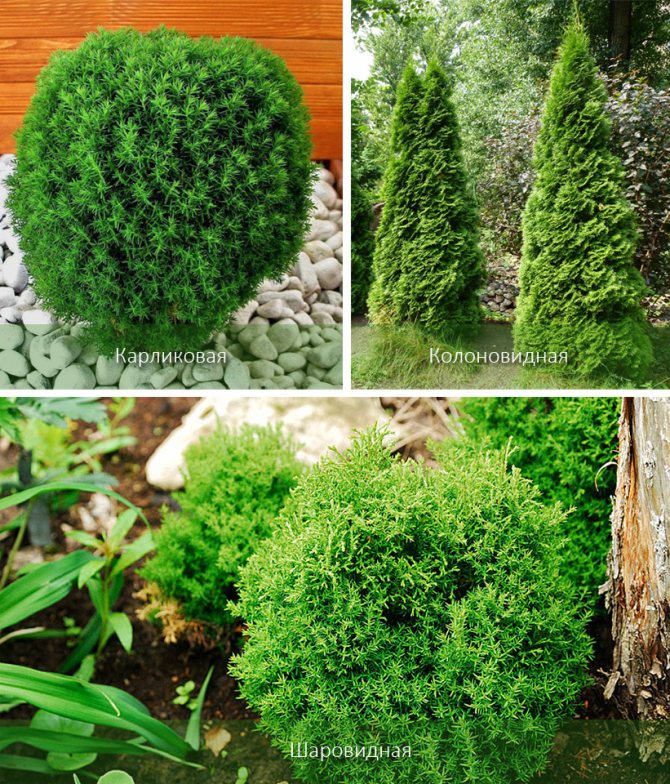

The bark of the trunks in young specimens has a reddish-brown smooth surface, and with age it begins to exfoliate, move away in stripes and acquire a grayish tint. The root system is developed, superficial.
Thuja, undemanding to special conditions, grows well in cities with polluted air, easily tolerates frosts. It is widely used to create topiary compositions. It can be shaped in a variety of ways, and pruning has a beneficial effect on its health.
Thuja: home care
In the absence of your own garden plot, you can grow a small miniature tree at home. Thuja in a pot today it does not seem strange, but quite an adequate solution for those flower growers who want to have a coniferous plant in their home.
There are no additional aspects of care here. It is only important to carry out timely watering and provide the plant with fertile and nutritious soil.
For planting the presented plant at home, choose the eastern thuja and the Ploskovetochnik variety. Planting a plant for self-cultivation in a pot is carried out according to the same principle as described above.
An exception is the absence of a transplantation point to a permanent place - after planting a seed or cutting in a pot with soil, the plant remains in place until fully ripe. The small volume of the container will not allow the shrub to grow as high and wide as possible.
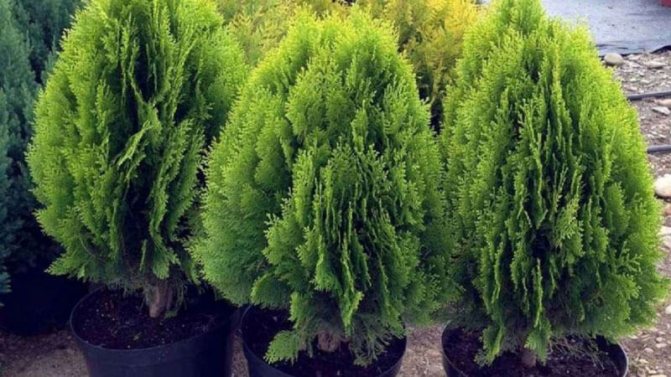

Principle, how to care for thuja at home, is enclosed in the following order:
- Planting a plant in a pot requires good drainage at the bottom of the pot. You can use a regular tray, which will also help remove excess moisture.
- The soil can be enriched with useful microelements by mixing four parts of sod land with two parts of coniferous. Only part of the sand is added to the mixture - the result is a soil suitable for planting seeds or cutting.
- The pot must be placed on a north or west window - this will provide diffused light suitable for normal growth for the shrub.
- For optimal cultivation, an already mature tree is provided with a temperature of 10-15 ° C. In the summertime, it is necessary to take the pot with the plant to the balcony so that it receives its portion of air procedures.
- Watering is carried out as needed as soon as the soil dries out. It is important not to allow excessive moisture or dry out of the soil, all this will lead to the death of the plant.
- Thuja can calmly tolerate any whims of air humidity in the room. However, excessive "air drying" should not be allowed. It is better to maintain a moderate climate in relation to indoor humidity. In the summer, in the heat, the plant should be sprayed.
- For the normal formation of a bush, the plant is pruned.
When growing thuja, one should not forget about timely feeding with special universal fertilizers, which are carried out in the spring and during the summer for a favorable and rapid growth.
From August to September, you can start propagation by cuttings.
Varieties of thuja
Thuja has various forms:
- columnar (conical or pyramidal);
- spherical;
- dwarf.
There are five types in total:
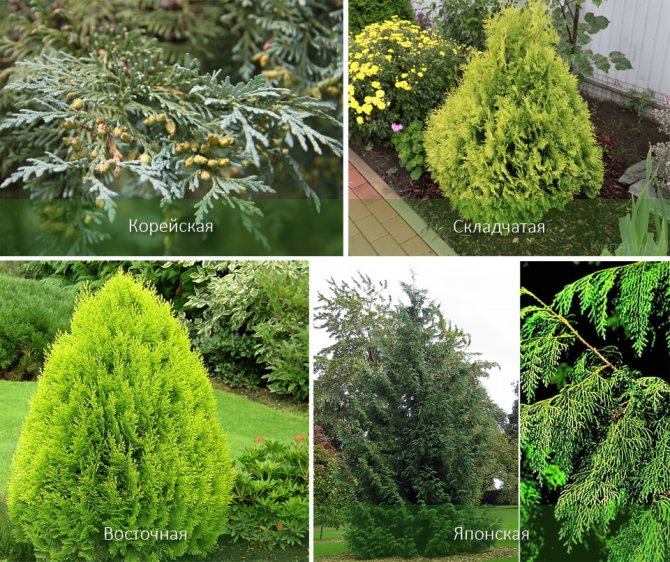

- western - the most unpretentious and frost-resistant, most often cultivated in the middle lane, great varietal variety;
- Korean - frost-resistant, does not tolerate dry seasons, grows well only in environmentally friendly areas, the crown is pyramidal, the needles are soft, lush, from green to whitish, with a citrus-coniferous aroma;
- Japanese - slow-growing, the maximum height of the bushes is up to 5 m, the crown is spreading, soft, the color is pale green with silvery shades, frost-resistant (but does not tolerate winter well), does not like drought;
- folded - long-liver (500-600 years), belongs to the largest representatives of thuja, in nature some trees grow up to 70 m, with a trunk diameter of about 2 m, ornamental species grow up to 15-20 m, the crown is dense, pyramidal;
- eastern - whimsical to care for, popular because of its decorative effect, very thermophilic, does not tolerate cold weather, prefers stony soils, the crown is light green.
Of these five, more than 120 varieties have been bred.
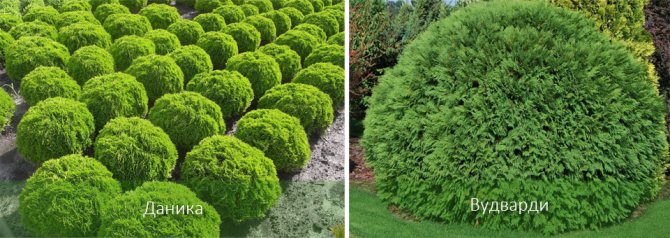

These are mainly representatives of the western thuja. The most common in gardens and parks in the middle lane:
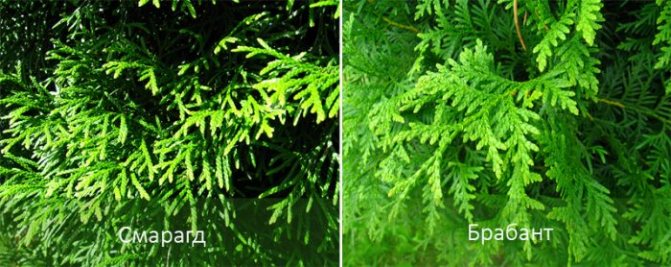

Watering and sprinkling mode
Adult plants, like seedlings, are very fond of a humid environment, and it is better if water comes from all sides, and not only from the soil. Regular watering is a prerequisite for keeping the plant in “good physical shape”. A sufficient amount of moisture is immediately reflected in the appearance of the thuja - the branches become elastic, and the needles become shiny, with a more saturated shade.
The minimum watering regime is one bucket of water (about 10 liters) in the root area once a week, in the dry period - 2-3 times a week. In a drought, thuja reacts instantly to a lack of moisture: the top of the crown turns yellow, a large number of cones appear, which is not always appropriate for a decorative effect. The best time of day to water is early morning or dusk.


Watering thuja, especially its seedlings, should be very careful so as not to wash out the soil from the area of the root collar, which is at the same level with the soil surface
Thuja loves sprinkling no less abundant watering - spraying the crown from a spray bottle or a hose with a special nozzle.The water washes away the dust, the appearance of the tree is renewed, the thuja becomes fresh and clean, and a pleasant pine smell appears in the air. Do not be afraid to spray thuja once again, irrigation 1-2 times a day is only good for her.
Planting thuja in open ground
Growing thuja is not so difficult, even a beginner can handle it. To get healthy, beautiful plants, you need to take care of the following in advance:
- evaluate the general view of the site, lighting (the presence of tall trees), proximity to other plants, find a suitable place;
- take into account the climatic conditions and the type of soil;
- decide on the season;
- choose healthy seedlings;
- land according to the rules;
- provide the necessary care.
Selection of seedlings and planting conditions
Young thuja are usually sold in container containers, in sacking with soil. According to some signs, it is already possible to determine in advance how viable they are and how they will take root in a new place. By the way, plants aged 3-4 years are better accepted and grow faster, they can overtake those that are already 5-6 years old in growth.
When examining seedlings, you need to pay attention to the following points:
- if the crown is lush, has a uniform color, then the roots are in order, such an instance will quickly take on a new place;
- the color of the needles is of different shades of green or golden, if it is brown, then the plant is not healthy, it does not receive nutrients;
- it is better when the crown of the seedling is symmetrical;
- the trunk must be undamaged;
- the needles of a healthy plant do not crumble: you can check if the plant is alive by squeezing the needles in the palm of your hand - if it instantly straightens out, when it is released, then everything is in order with the seedling;
- the soil must be moistened, because when the roots are in a dry state for a long time, the plant may not accept;
- it is better, as far as possible, to check the rhizomes, which should be juicy, healthy, white-pink shoots (brown and soft to the touch are already rotting due to improper watering).


Thuja planting dates
There is no exact date, you need to choose depending on the climate conditions in the region. The right time depends on how early spring comes or when autumn frosts come. It can be planted from spring to autumn, observing the correct conditions for a particular season.
Spring planting is recommended, since during this period the activation of the growth of roots and shoots begins, which allows the plant to quickly begin, and during the entire warm period the thuja manages to get stronger. In spring, it should be planted in March-April, when stable warm weather sets in in the region.
If the planting is done in the summer, then you need to provide thuja with regular watering, to prevent the soil from drying out, the best time is in August.
In the fall, you need to calculate the period for the plant to have time to start before stable frosts.
- The middle lane and the Moscow region - no later than mid-October;
- Southern - November;
- Urals and Siberia - end of September.
Location
If you immediately find a suitable place for a thuja in the garden, then in the future you will not have to spend a lot of time on additional care for it - watering, combating yellowing and shedding of needles.


What you need to consider when choosing a place:
- the site should be well lit, but protected from direct rays of the sun, only half-shaded is allowed, the shadow has a bad effect on the development of thuja;
- in the vicinity of large trees with roots that have grown in width, it is impossible to plant thuja, because they will act overwhelmingly, taking nutrients from the soil;
- she does not like the neighborhood with asters, peonies;
- does not tolerate drafts, you need to choose calm areas;
- these conifers adore moisture, but react negatively to water stagnation at the roots, so they choose places where the groundwater level is not closer than 1 m to the surface.
You can plant thuja next to it in the form of a hedge, the distance between them should be 50-60 cm.
A suitable soil should consist of turf, peat (2: 1), to which you can add humus (1), and in the case of leafy soil, add peat, sand, humus to the latter (2: 1: 2: 3).
Additionally, the mixture is enriched with superphosphate or nitroammophos - about 3 handfuls, everything must be mixed well so that the fertilizer does not burn the root system.
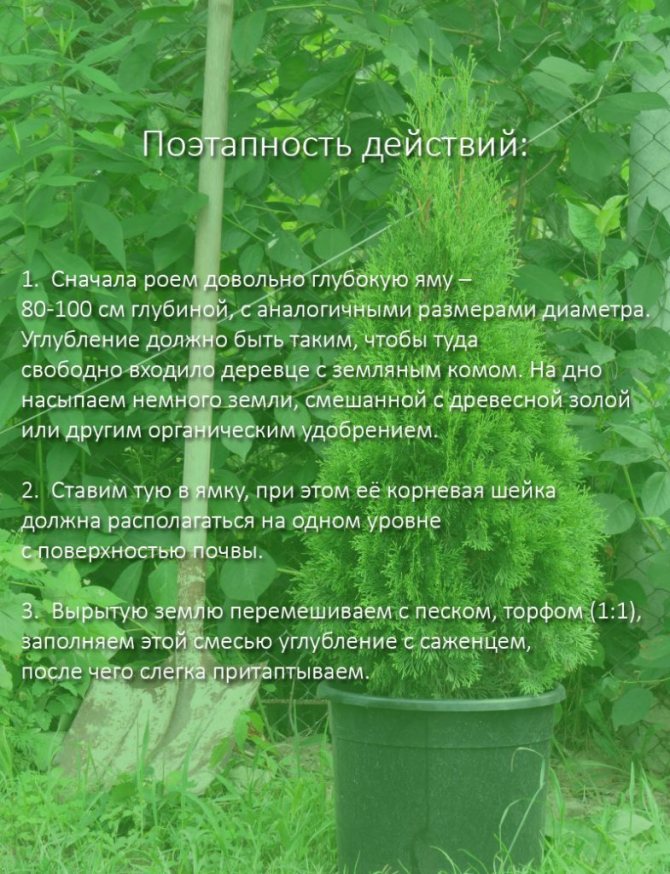

Landing rules
- Pre-prepare the landing pit. At the bottom, a drainage layer (10-15 cm or more) is made of broken brick, crushed stone, expanded clay. Then they fall asleep with the prepared fertile mixture.
- Half an hour before planting, the thuja is watered with a root formation stimulator - in addition to the benefits for the root system, this will allow you to gently get the earthen ball out of the container.
- You can remove the plant from the container only when everything is ready for planting. Because its roots dry out quickly and the thuja may not take root.
- A bucket of water is poured into a prepared pit with soil in order to avoid its large subsidence in the future.
- Thuja is placed in the soil so that its root collar is 3-4 cm above ground level - this is a margin for soil subsidence. Then it will align with the surface.
A too high or deep position of the root neck should not be allowed.
- The rest of the nutrient soil is poured around the seedling and watered. After subsidence of the soil, add another flush with the surface.
- The planting site is mulched with compost or wood chips. They should not touch the trunk, otherwise the tree will rot.
Outdoor thuja care
If the planting is done correctly, then further care for the thuja will not take much time. While the plant is being taken it is watered regularly. Young (10 l), adult (50 l), morning or evening.
Periodically, the ground around the thuja is loosened and weeds are removed, very carefully, the roots are shallow.
The next top dressing is carried out six months after planting, and then a fairly seasonal spring. Use a coniferous fertilizer.
In the spring, they carry out sanitary pruning of branches, and in the fall - decorative.


Wintering thuja
At the end of autumn, still immature young plants are covered from frost with spruce branches, burlap. Mature trees do not cover, but only mulch the roots, adding peat and laying coniferous branches. Tie the branches to the trunk so that they do not break off under the weight of the snow. Free in the spring.
Culture care
Planting thuja is just the beginning of the growing process. To get a beautiful, healthy plant, you need to properly care for it.
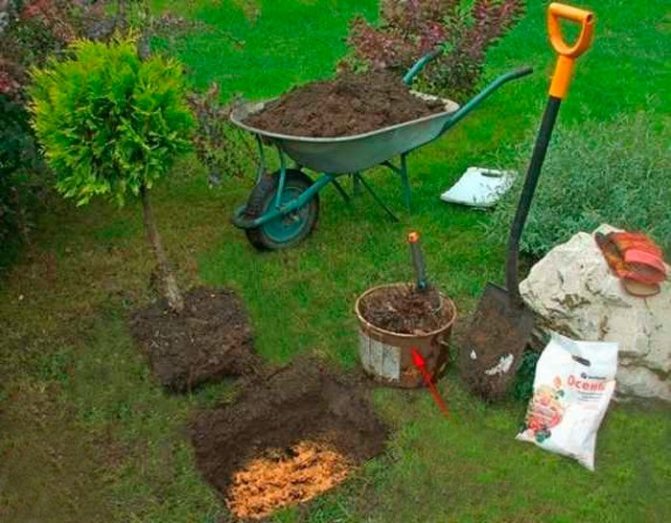

Plant thuja
Apricot in the Urals (planting and care)
Basic principles of proper care:
- Watering. Thuja is a moisture-loving plant that requires regular moisture, especially young trees. During the hot period, watering is carried out at least once a week, preferably in the evening. Thuja also responds well to sprinkling - the crown is well moistened, and dust is washed off. Towards the middle of autumn, watering stops - the plant must rest before winter.
- Loosening. It is advisable to carry out after each watering or heavy rain. The soil should be loosened carefully and shallowly - the roots of the plant are located close to the surface.
- Pruning. One of the most important processes. It is recommended to trim twice a year: in spring and autumn. First, sanitary pruning is carried out: weak and dry branches are removed. After this, formative pruning is performed. In cold regions, the second pruning should be done in the second half of the summer.
- Top dressing. Thuja develops well without additional fertilizers. If necessary, fertilizing can be carried out in the spring in the form of nitrogen-containing fertilizers, in the summer - in the form of potash fertilizers. If complex funds were applied during planting, then re-fertilization is carried out only in the second year.
Important! In the case of excessive feeding, thuja can bloom profusely and for a long time (the process is called dusting), forming cones. According to gardeners, this phenomenon negatively affects the decorative effect of the plant.
Tuyu can be used as an ornamental plant, as a tapeworm, and in combination with other conifers. Ferns, barberries, hosts, echinacea can become interesting neighbors for this ephedra. In addition, the thuja can be planted near the house without any problems, it perfectly ionizes the air and is not a fire hazardous plant - the trunk is dense, the branches contain high humidity.
Top dressing and fertilizers
You need to be very careful about feeding the thuja. Excess fertilization leads to a rapid growth of green mass, the crown loses its desired shape. If necessary, the poor condition of the plant, yellowing, slow growth, you can carry out top dressing in the form of complex fertilizers in the spring or alternately with nitrogen, potassium and phosphorus dressings.
For your information. Nitroammofoska and iron chelate have a good effect.
Autumn care and wintering
With the arrival of autumn, the thuja begins to prepare for rest. Care at this time is not as intense as in spring and summer, and has its own tasks. By the end of summer, the thuja are no longer fed to stop its growth. Before frost, the plant should slow down its life cycle and go into hibernation. This is the only way to protect her from death.
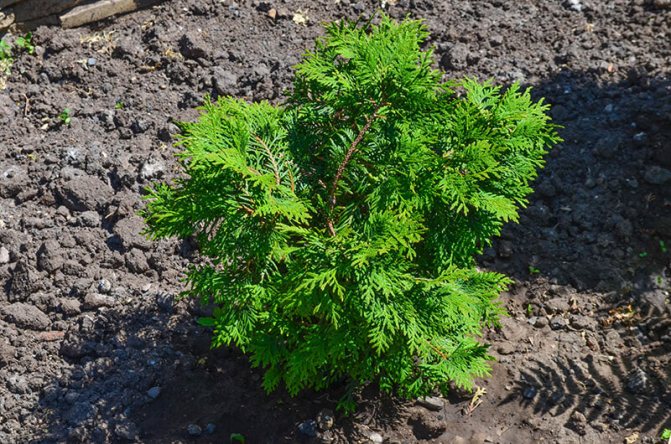

In the fall, they begin to water the garden plantings abundantly, since thuja sleeps in winter, but nevertheless it develops and needs moisture. The last loosening is also carried out in the fall to saturate the earth with oxygen. Only then the site is mulched with sawdust, peat or tree bark.
Advice: for northern regions, choose suitable varieties - "western". They are more frost-resistant.
Many people prefer to transplant thuja in the fall. This decision is somewhat rash, since the plant may not have time to take root before winter, however, if they nevertheless took up such a responsible occupation, then, according to the recommendations of experts, this should be done before the onset of constant cold weather, namely in September. The transplant is carried out by the transshipment method, keeping the main part of the earthen coma on the roots - this way the plant will quickly take a new place.
The main mission of autumn care is to protect plants from impending frosts. Thuja is a plant of a warm climate. Most of the thuja species do not survive our winter. Therefore, the plant must be prepared for the cold period in order to minimize the risk of freezing of the branches or more significant losses. While the temperature is still not too low, it is enough to cover the base of the tree with spruce branches.
For the winter, seedlings up to three years old (and all thermophilic species) require shelter. Any nonwoven fabric is suitable for this purpose. But it is important that it allows air and light to pass through and does not interfere with photosynthesis. Burlap can be used, but it will not cover the entire plant area. Usually, spunbond is used for shelter or a wooden frame is built and covered with material. To facilitate the task, the branches of the young thuja are pulled together with a rope, pressing against the trunk. Then only the plant is wrapped with a covering material. The roots are protected with a thick layer (at least 10 centimeters) of sawdust, bark, peat, compost or old grass mulch.
Before sheltering, yellowed and dried branches, as well as diseased and broken ones, are cut out from the plant.


With the arrival of warmth, they open it. This must be done as soon as there is practically no snow left, and the air warms up to 15 degrees Celsius. It is important not to be late with cleaning the shelter, otherwise condensation will form inside, which will cause the development of the fungus. There is also no need to rush - wood can get sun-frost burns.
As soon as the soil under the trees opens up, water-charging irrigation is carried out. Water must penetrate to a depth of 50 centimeters, so you need to pour generously. Moisture will quickly awaken the roots, and the plant will begin growing faster.
Autumn garden work
In the fall, it is necessary to stop watering so that the thuja can prepare for wintering. Be sure to shelter for the winter those plants that have not yet turned five years old.Thuja is first spud up in height, mulch is laid around the bush - it is better if it is peat. From above, the bushes are covered with spruce branches.
Plants that have crossed the five-year threshold can winter well without shelter. But in especially snowy winters, snow can break the branches of the plant. You can tie the shoots with twine to prevent damage to the crown.
In the spring, the sun can harm thuja, so you need to throw covering material on the bushes. Sometimes cracks can form on the bark, this happens in winter, if the temperature changes frequently. The garden pitch will help to correct the situation, with which the cracks are covered.
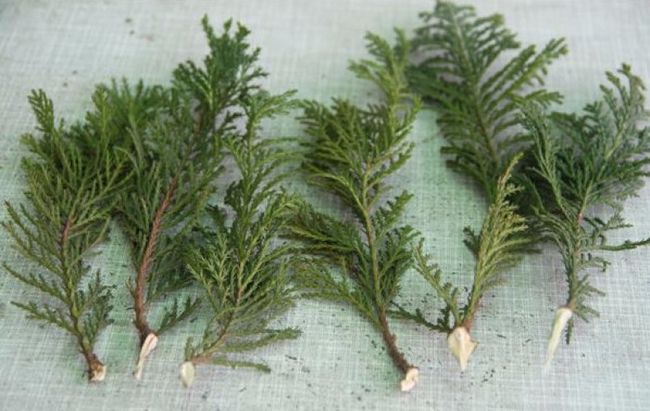

Selection of varieties and seedlings
Depending on the external characteristics and characteristics of cultivation, there are two types of thuja - eastern and western.
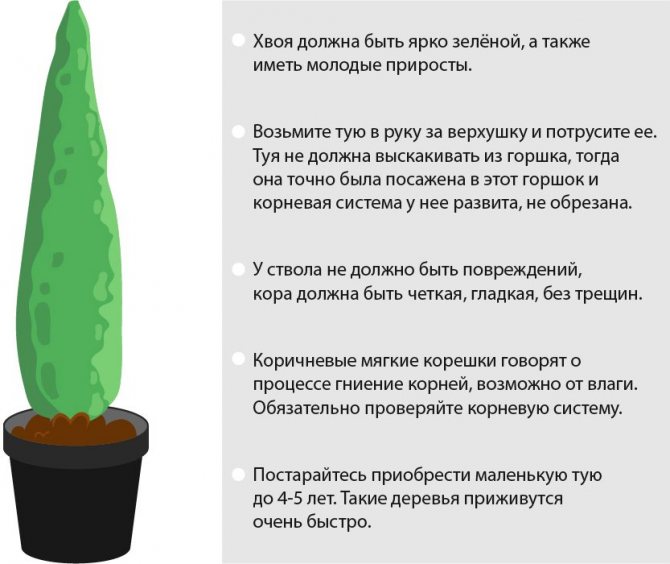

Eastern thuja (or flattened) consists of branched flat shoots that look like plates and form several trunks. This species can only be grown in regions with a warm climate, therefore it is cultivated in gardens in Japan, China and Korea.
The crown of the western thuja is formed by many lush shoots that begin to grow from one central trunk. This type of tree is grown in Canada, the USA and Europe, because it needs a cold winter. Western thuja is distinguished by its hardiness and unpretentiousness to environmental conditions, therefore it is more suitable for regions with moderately cold or frosty winters.
See also the most common blue spruce varieties.
Each of the species is represented by many varieties.
The best ones are:
- Danica. Low-growing tree (up to 60 cm in height), so it is convenient to use it to create compositions from other ornamental plants and flowers. The crown diameter is 0.5–1 m. The positive qualities of the variety are unpretentiousness to the nutrient composition of the soil, compact size and the absence of the need for frequent pruning. The disadvantage of Danica is its weak drought resistance and sensitivity to waterlogging of the soil.
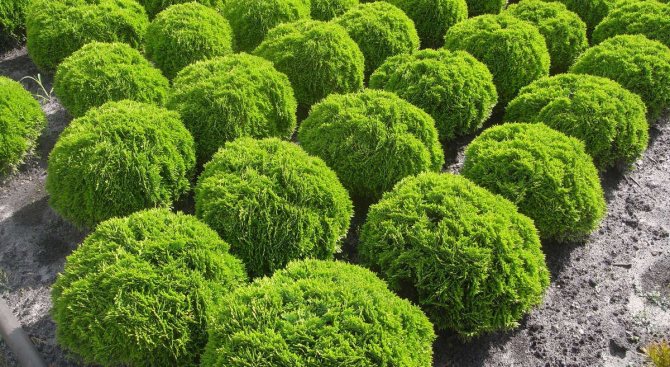

- Globosa. Its height does not exceed 60 cm, and the crown width reaches 1 m. The advantage of this variety is that it can act as an effective addition to any composition of shrubs, as well as be an independent decoration of the site. The downside of the tree is the increased demand for the nutrient composition of the soil, and the crown loses its attractive shape with age.
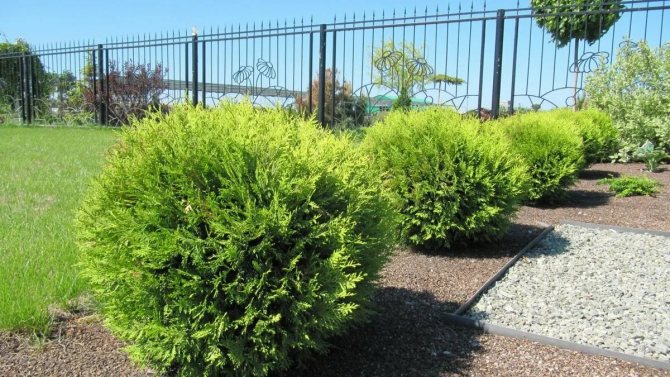

- Hoseri. The tree is ideal for growing in small areas and flower beds, because. the diameter of its round crown is only 40 cm, and its height is no more than 60 cm. The compactness of the representatives of the variety is their main advantage. The disadvantages of the tree include the exactingness of watering and the composition of the soil.
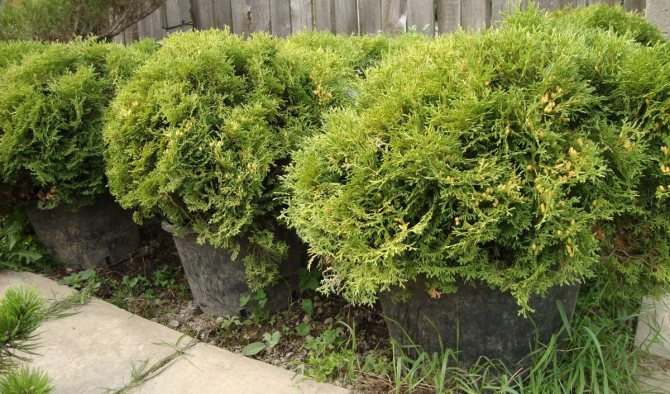

- Holmstrup. This variety is tall. An adult tree can grow up to 2-3 m, and its lush crown looks good in compositions with other ornamental plants. The advantage of thuja Holmstrup is that it retains its conical shape even in the absence of trimming. The disadvantage of the variety is susceptibility to drafts and demands on the nutritional composition of the earth.
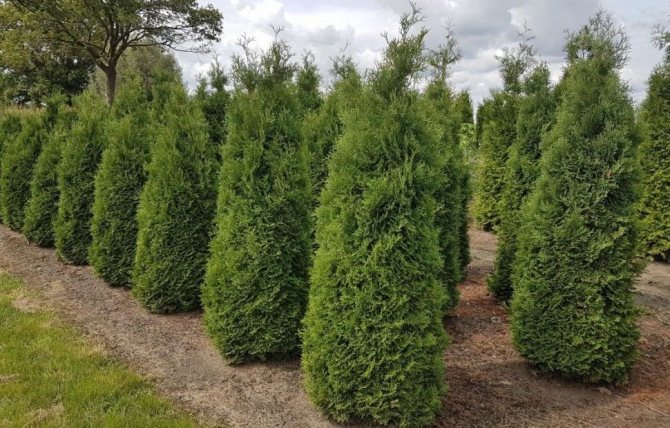

- Smaragd... Thuja of this variety it is particularly large in size - up to 5 m in height and 1.5–2 m in diameter... The tree can be grown on any soil, and its needles have a particularly bright emerald color. The advantages of Smaragda are high frost resistance, durability and preservation of an attractive crown shape throughout the entire period of the tree's existence. The disadvantage of the variety is the dependence of the color of the needles on sunlight (in the shade, the shoots of the tree become dull).
Video: thuya Smaragd
- Brabant. The height of an adult tree is about 3.5 m, and the shape of its crown outwardly resembles a powerful column up to 3 m wide... Thuja grows quickly and is often used to create hedges. The main plus of the variety is the preservation of the correct shape of the crown, even without formative pruning.The disadvantage of wood is its increased sensitivity to excess moisture in the soil.
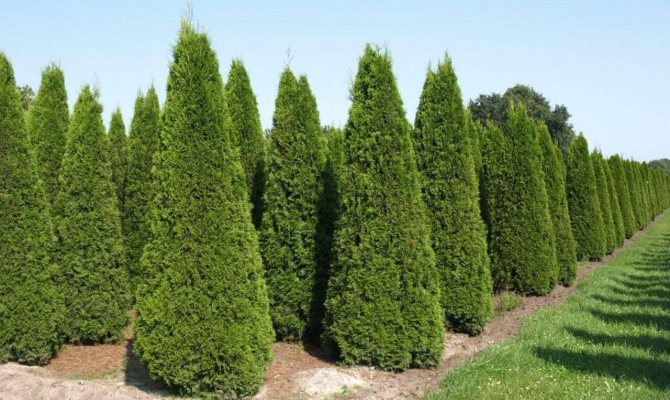

- Golden Glob... The main advantage of the variety is the non-standard spherical shape of the crown and the golden color of the needles. The diameter of an adult tree is about 0.8 m, and it is usually planted in combination with flower beds and ornamental shrubs growing in containers. Among the disadvantages of the variety are susceptibility to waterlogging and demands on soil fertility.
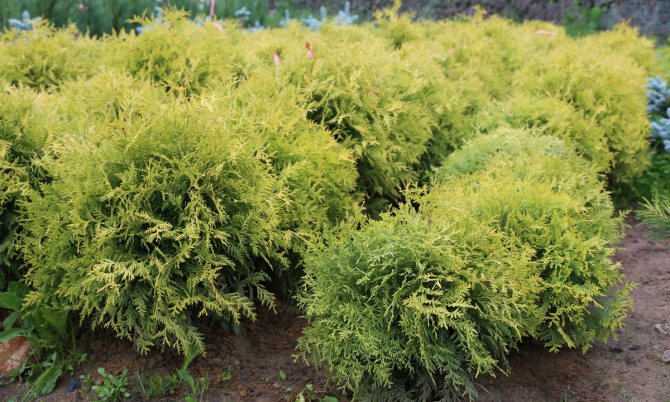

- Aurea nana... Representatives of this variety have a compact and dense ovoid crown formed by branches with golden needles. The height of the thuja is up to 1.5 m, and the width is about 70 cm. The advantage of the tree is that with the onset of winter, each needle turns into a rich orange color. The disadvantages of Aurea Nana include low frost resistance and increased susceptibility to cold drafts.
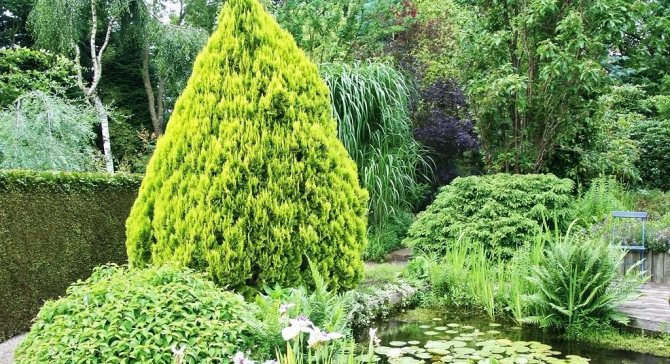

- Jystynka... Tree reaches a height of 1.6 m and has a compact columnar crown, formed by dense needles of saturated green color. More often this variety is used as an element of small rock gardens and flower beds. Among the advantages of Giustinka are unpretentiousness to the composition of the soil and good drought resistance. The disadvantage of the variety is that it does not tolerate a cold climate and loses its decorative appearance when grown in a cold draft.
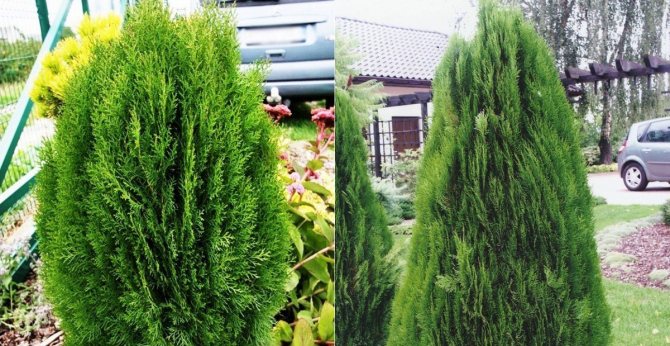

Regardless of the variety you choose, you need to know the rules for buying seedlings. It depends on the quality of the planting material how successfully the tree will take root on the site.
- The main signs of a good seedling are:
- healthy appearance;
- absence of dry branches, damage or traces of infection by infections;
- closed root system (container or burlap with soil);
- rich color of needles, typical for a particular variety;
- moderately moist earthy clod around the roots of the tree.
Did you know? The smallest variety of thuja is Little Boy. The height of an adult tree is only 40-50 cm, and the crown has an emerald color and a spherical shape.
Landing
Planting seedlings in open ground is planned for the spring. To do this, you need to prepare the site. This should be an area with sufficient lighting - at least 6 hours of full sun daily. The soil must be drained. Its acidity does not matter, although thujas prefer slightly acidic soil.
Check out how far to plant thuja from each other.
Landing dates
Next spring it will be time to plant sprouted young seedlings. Since the plant is still weak and tender, it can be planted in the soil when the air temperature warms up to + 10 ° C. Before planting, be sure to harden the seedlings. To do this, take them out of the room onto the street every day for a week, increasing the time of stay every day.
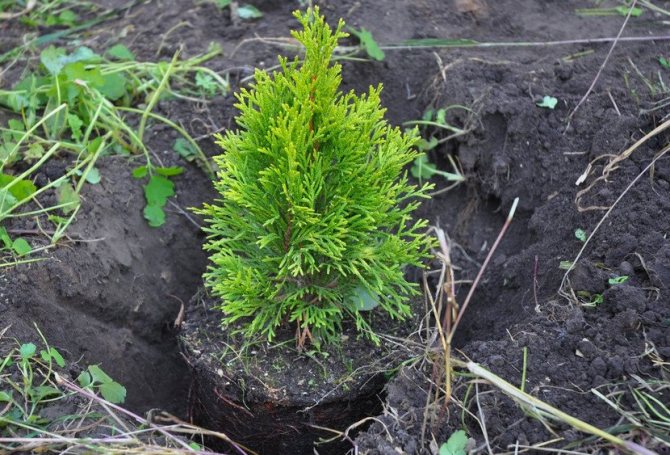

Site preparation
The soil under the thuja should be water-permeable and nutritious, so start by making sure it has a good flow rate. Dig a hole up to 60 cm deep, equal to the planting one for an adult tree, and completely fill it with water. Wait for it to drain and refill it a second time. If after 1–2 hours there is still water in the pit, then a drainage layer should be made during planting.
Important! Yellow needles at the seedling
—
a sign that it is drying up and almost dead. Such material is discarded.
Soil quality also matters. Heavy clay soils contain no more than 5% organic matter, so they are diluted with sand for looseness and garden soil or compost for nutrition. To plant a one-year-old seedling, you will need a compost bucket.
Sapling selection
If there is a lot of planting material, but it does not suit you all, just select those seedlings that will be the tallest. Good planting material has bright green needles. It has a straight trunk without damage and traces of diseases. When removed from the pot in which it grew, numerous and developed roots are found.
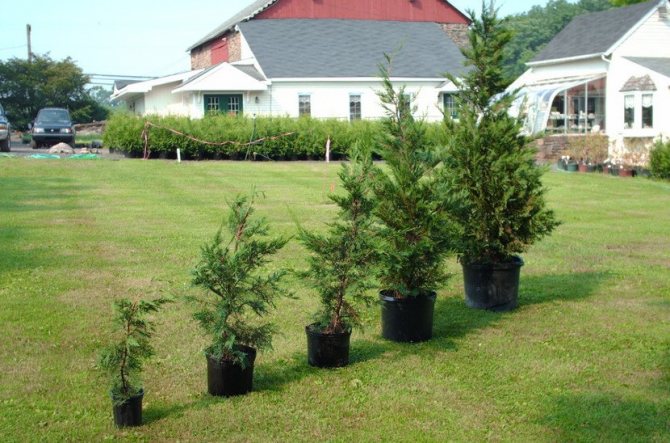

Step-by-step disembarkation
For planting in a permanent place of growth, planting pits are prepared. Their depth should be 2 times the root ball, and their width should be 2-3. It is advisable to make the pit square. This will cause the roots to grow downward rather than curling in a circle as they do when growing in a pot.
Reproduction of thuja
Thuja can be propagated by seeds and vegetatively. Seed propagation is acceptable only for thuja species, but not for forms and varieties (decorative qualities will be lost). Moreover, it is a laborious and long process: it will take three to five years to grow a seedling. The seeds must be freshly harvested. They are subjected to natural stratification, leaving them in the fall under the snow.
In the spring, they are sown on the ridges, deepening by only 0.5 cm, lightly sprinkled with coniferous sawdust. Thuja shoots are covered with shields from the sun, the soil is kept loose and moist. They are fed with a weak solution of slurry (1:20).
Most often, the western and its forms are propagated by lignified cuttings (using 2–3-year-old shoots 25–40 cm long) and semi-lignified (the current year's growth is 10–20 cm long, cut in June). Cuttings are cut off so that a small piece of old wood - "heel" remains on the base of the shoot. In this case, the cuttings root better.
They are treated with a solution of heteroauxin and placed in a greenhouse. The soil is prepared from a mixture of river sand with peat and sod land (in a ratio of 1: 1: 1), disinfected with potassium permanganate. The planting depth of the cuttings is from 1.5 to 2.5 cm.
Cuttings begin before the beginning of bud swelling, at the end of April - the first decade of May, and also after the end of shoot growth, at the end of June. From mother plants in any part of the crown cut off 2-3-year-old branches 25-40 cm long. Cuttings (10-20 cm) are cut from them with a heel - a piece of old bark. They are treated for 12 hours with an aqueous solution of heteroauxin (20 mg / l) and planted in a nursery to a depth of 1.5 to 2.5 cm. Turf soil is poured into the nursery, and on top is a layer of river sand with peat (1: 1). Before planting the cuttings, the ground is bayonetted, disinfected with a solution of potassium permanganate and spilled with water.
One of the most important conditions for rooting cuttings is to maintain high air humidity, but without waterlogging the substrate. To do this, use sprinkler installations with nozzles that create artificial fog, or cover the cuttings with a film, having previously watered them from a watering can with a fine strainer. At an air temperature of 25 °, the installation of artificial fog is turned on 6 times daily with an irrigation duration of 0.5 to 1 min (at temperatures up to 20 ° - 4 times). In hot sunny weather, the film is whitewashed with a lime solution. Weeds are periodically weeded and measures are taken to combat pests and diseases.
As soon as the cuttings take root, they begin to harden - reduce watering and ventilate, opening a nursery for a while. For the winter, somewhere in November, they are covered with a leaf, sawdust or spruce branches, and when frosts come down to minus 5-7 ° they are also covered with a film. In some areas (for example, in the Chernozem zone and to the south), thuja cuttings winter without shelter, under natural snow cover. In the spring, the insulation is removed, the plants are corrected after winter, pressing them into the ground, and weeding.
In a greenhouse, it is very important to maintain high air humidity without waterlogging the substrate, therefore spraying is more desirable than watering. Rooted cuttings are ventilated, hardened. In November, they are insulated with leaves, sawdust or spruce branches, when frost comes (-5 ..- 7 ° C) they are additionally covered with a film.
Transplant rules
You can transplant these plants from March to November.... And if this procedure is performed correctly, then the thuja will outlive it well. You must first dig a planting hole, and then remove the tree. A circle should be drawn around, the diameter of which is about 1 meter. The trunk of the thuja should be located in the center.
With the help of a sharp shovel, a circle is dug out, after which the soil is carefully lifted off.In this case, assistants will be required. After the plant has been removed from the soil, it should be placed on a trolley and transported to a new place of growth.
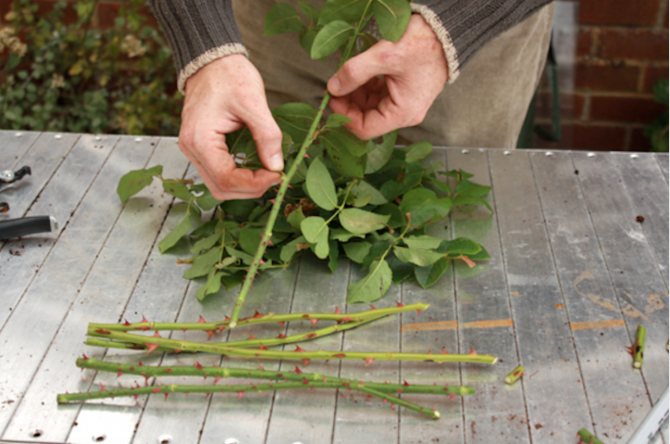

Due to the simplicity of growing thuja, it is the favorite of many gardeners, and is also widely used in landscape design. In summer cottages, these crops are grown both singly and in a mix with other evergreens.
Thuja also has a lot of useful properties. For example, if you stay next to this plant for half an hour, then the thoughts and feelings of a person come immediately in order, nervous tension and stress disappear. These crops also have a positive effect on the air, killing all harmful microorganisms in it.
Many different experiments can be carried out to plant these conifers. Tui look equally impressive both in hedges and in single cultivation. Very often, gardeners use them to decorate alleys.
Pruning and artistic haircut
For the first two years, the thuja must be left alone in order to allow it to finally take root, monitor the growth rate, and determine its needs. In the third year, you can start pruning the crown.
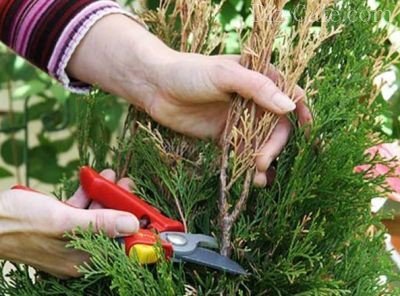

First of all, the crown is relieved of dried, lethargic, branches damaged during wintering, and then they decide whether additional thinning is necessary: the loss of density also affects the decorative properties
There are several rules for correct pruning:
- the main procedure is carried out in April, then throughout the summer, up to cool days, the shape of the crown is corrected;
- dry weather is suitable for pruning;
- before cutting, dry or diseased twigs should be removed, and in order to improve air circulation, slightly thin out the plant, sacrificing healthy shoots;
- to maintain the stability of the chosen art form, all shoots of one-year growth should be removed;
- if growth is needed only in width - cut off the top of the crown.
Artistic haircut consists in giving the plant a certain, most often the correct geometric shape - a ball, pyramid, cube, column.
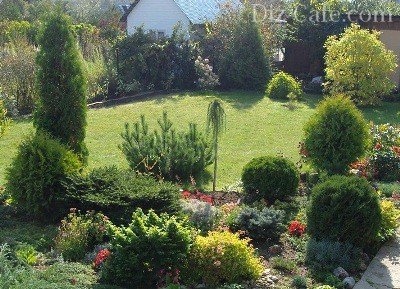

A composition often found in suburban areas with the participation of conifers - several design options for thuja surrounded by flowers and ornamental grasses
Skilled craftsmen manage to turn conifers into figurines of animals or fabulous creatures. It is better for inexperienced, novice summer residents to start with simpler compositions - low hedges, lawn "balls" or simple two-tier cascades.
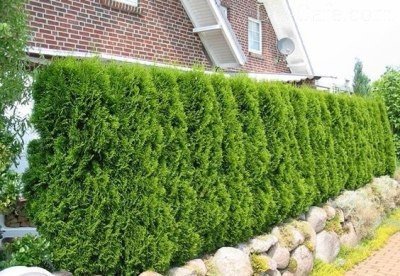

A thuja hedge in the country performs several useful functions: it protects the summer cottage from uninvited guests, is a decorative element and absorbs street noise
Choosing a place for growing
Few people know that the soft scales that cover the branches of the thuja produce useful phytoncides. It is for this reason that it is useful to plant these crops in your summer cottage. Planting a thuja and caring for it in the open field means growing in areas where there is a slight shade. Direct sunlight on branches can damage the plant.
In the summer and spring, under the sun, the trees begin to dry out and wither, and when weakened, they survive the winter rather badly. If you plant this ephedra in too thick shade, this will negatively affect the decorativeness of the culture. Excessive shading causes slow development, pallor of leaves, lack of splendor.
Cultures categorically do not tolerate strong winds and drafts, especially when it comes to planting thuja and caring for it in the Urals, where a very unpredictable climate prevails. Landing sites should be selected reliable, protected from sudden gusts of wind. If the groundwater is located next to the plant, then this, on the contrary, will have a positive effect on its development. Thuja prefers to grow on absolutely any soil:
- marshy;
- clayey;
- sandy loam;
- peaty.
The main condition for growing a coniferous plant is sufficient moisture. However, it is worth paying attention to the fact that stagnation of moisture in the root system can lead to the death of the culture. If the soil is too moist and heavy, it is imperative to pour a layer of about 20 cm of drainage on the bottom of the hole during planting. For this, it is best to use large pebbles or broken brick. In swampy areas, you will have to dig special trenches designed for laying drainage pipes. The most beautiful trees grow in loose fertile soil, which consists of three parts:
- peat;
- sod land;
- sand.
If the culture grows on poor loam or in sandy loam soil, then additional attention will have to be paid to fertilization.
Thuja: an amazing tree of life
Worldwide thuja tree highly appreciated for its decorative effect. This evergreen coniferous breed is beautiful both in winter and in summer. Under favorable conditions in nature, it can reach a height of 20-30 m, and the trunk is 180 cm in diameter. In culture, the thuja is much lower. At a young age, the tree is especially graceful. Its crown is narrow-pyramidal, later it becomes ovoid, but does not lose its decorative effect. For this, the thuja is called the "cypress of the North" in contrast to the real cypress growing in the south. It is difficult even to imagine that this fluffy and already familiar tree in parks and on plots is not found in the wild nature of our regions. Thuja came to us from the southeastern part of Canada and the northern part of the United States several centuries ago. Under natural conditions, in its homeland, thuja grows up to 20 meters, in our latitudes it is more customary to see it about 10 meters high.
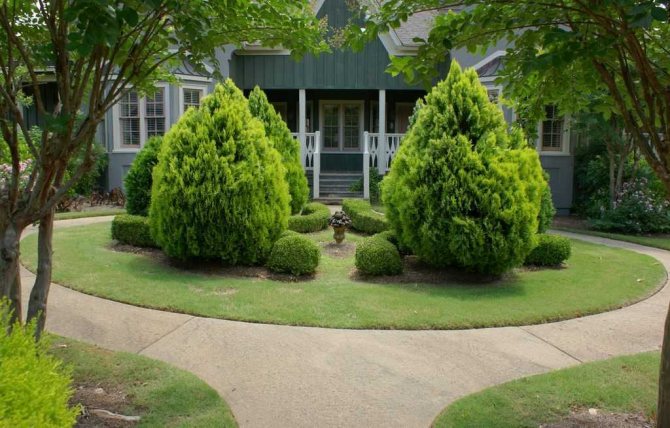

Flowerbed with thujas.
If you need to choose a plant for a hedge, a resting corner, or to decorate a porch, a terrace - stop at the thuja, especially when there are swampy and peaty soils on the site, unsuitable for most fruit and berry crops.
The best plants for creating dust-proof hedges (read more)
Care features
Thuja is unpretentious in maintenance, and it is very easy to care for it. You don't have to waste a lot of time. In order to grow successfully, she will need:
| Month | Act |
| February | Sanitary and molding pruning. |
| March | Application of a shock dose of fertilizers. |
| April - September | Regular watering. |
| October | Intensive watering before wintering. |
| November | Preparing the tree for winter. |
Watering and feeding
The peculiarity of watering thuja is as follows: it tolerates moist soil well, but poorly - swampy. Thuja is a very slow consumer of moisture, and if the water does not have a drain, then the roots will constantly be wet, which will end in rotting and death of the tree.
For newly planted bushes, watering is organized more often - every 2-3 days. Water is poured so as to moisten the root zone. Then the frequency of irrigation decreases - up to 1 time in 5 days. A 7cm layer of mulch will also help maintain more uniform soil moisture and temperature.
Disembarkation stages
Preparing the soil for thuja when planting
What soil is needed for planting thuja? Like all coniferous varieties, she loves slightly acidic soils. Therefore, for planting, you can prepare a mixture of sod land, peat and sand, or purchase a ready-made mixture for conifers. Soil types such as sandy loam and clay are also suitable.
Pit creation
The size of the hole will depend on the clod and the volume of the root system. You need to dig so that the depth is about 30 cm deeper, and the width is 40 cm.If seedlings of different ages are planted, we focus on the most adult specimen: in this case, the width of the holes can vary from 1 to 5 m.When the plants are planted along the alley , then you need to dig holes so that the distance between the plants varies from 3.5 to 4 m.Pour soil mixed with rotted manure or compost at the bottom of the hole.
Planting a plant
Immediately before planting, the thuja must be carefully examined: the root system of the tree must be well developed and not damaged. Immediately before planting in the soil, the roots must be immersed in water and kept there until all air bubbles have come out of them. After that, we lower the seedling into the hole and place it in the center so that the root collar is just above the surface of the soil. Now we hold the tree with one hand, and with the other we cover the hole with earth. Gently compact the soil. Now our seedling needs to be watered abundantly with about 15-20 liters of water.
When the water is absorbed and the soil settles a little, the surface can be covered with mulch. If there is no mulch, then you can use peat, pine bark, wood chips. Thanks to this, the evaporation of moisture from the ground will slow down, and the roots will be protected from heat and cold. Mulch should not remain on the lower branches, otherwise the shrub may be oppressed in these places.
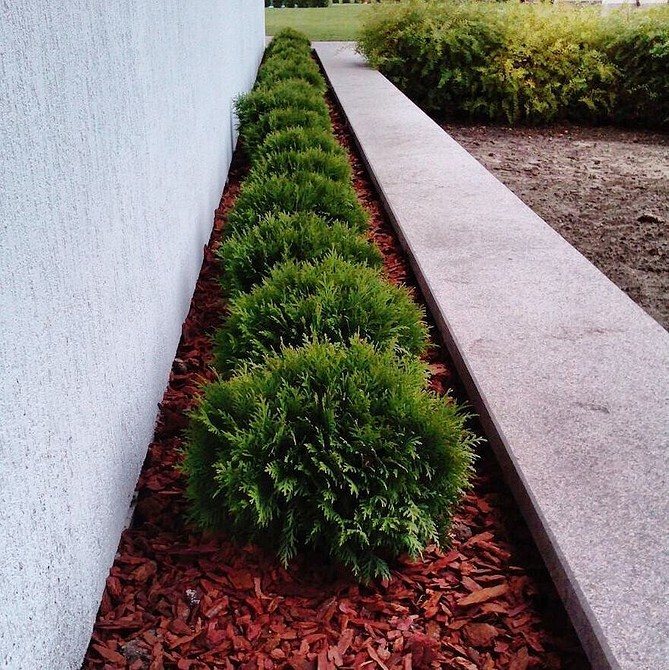

Instagram @lk_zeleno
The healing properties of thuja
The healing properties of yarrow are multifaceted, and traditional medicine has been using them for more than one century. The plant contains tannins, tannins, which have bactericidal, anti-inflammatory, soothing and astringent effects. They tone the skin and relieve irritation, therefore they are useful for acne-prone and porous skin, oily seborrhea of the face, as well as for sweating and for strengthening hair.
Vitamin K contained in the plant increases the strength of capillaries, helps stop bleeding and hemorrhage, heals ulcers and wounds. A large amount of carotene, which is part of the herb yarrow, eliminates brittle nails and hair, dryness, peeling and keratinization of the skin, counteracts the appearance of wrinkles and acne.
Yarrow enhances bile secretion, stimulates liver function and appetite, improves digestion and accelerates the absorption of substances. It is used as a hemostatic agent for diarrhea, dysentery, varicose veins, hemorrhoids, thrombosis and any bleeding, and as an anti-inflammatory agent for gastritis and enteritis.
Medicines are considered to be yarrow juice, infusion, decoction, ointment, oil and liquid extract. Some of these drugs can only be purchased at pharmacies, but some can be prepared on your own.
Broth: pour one teaspoon of chopped yarrow herb with a full glass of boiling water, cook at low boil for 5-10 minutes, cool and strain. Take half a glass 3 times a day for gastritis and stomach ulcers.
Tincture: Place 30 g of dry yarrow herb in a dark glass vessel, pour in 100 ml of medical alcohol, seal tightly and insist in a cool dark place for 10 days. If vodka is used instead of alcohol, then you need to insist 12 days. For internal use for pain and bleeding, 30-40 drops of the tincture are mixed with 50 ml of water. This preparation can be used to treat wounds and soak compress dressings.
Ointment: a handful of fresh yarrow leaves and flowers are ground in a mortar and mixed with an equal part of unsalted ghee. Use an ointment for bruises.
Yarrow preparations are contraindicated in case of increased blood clotting and diseases caused by this problem. Pregnant women are not recommended to consume yarrow juice. But even if you are not pregnant and completely healthy, prolonged or excessive use of yarrow drugs can lead to poisoning, accompanied by dizziness and skin rash.
Sections: Garden plantsPerennialsHerbaceousFloweringMedicinalAsteraceae (Asteraceae) WeedsHoney plantsPlants on T
After this article, they usually read
Thuja preparations are well known in medicine. Inhaling the aroma of thuja oil and taking baths with it will help relieve nervousness, restore lost strength, restore vigor and good mood. IN
with the help of thuja oil, they improve the functioning of the digestive organs, eliminate inflammatory processes in the kidneys, and also use it as a diuretic.
Thuja oil is widely used in folk medicine
Thuja oil is used to treat skin diseases, rhinitis, inflammatory processes of the respiratory system with asthma, cough, adenoids. In a word, thuja is a very useful plant, charging with optimism, cheerfulness, activity.
Site selection and preparation
In order for a young seedling to quickly take root in the open field, you need to know where to plant it.
The place for planting thuja must meet the following requirements:
- good light in the morning and partial shade in the afternoon - the sun's rays are necessary for the tree to grow the rich color of the needles, but constant exposure to the bright sun can lead to burnout of the shoots;
- no draft - under the influence of cold air currents, thuja is more often affected by diseases, and its branches can break in the wind;
- loose and fertile soil with neutral or low acidity - provides thuja with the necessary nutrients, passes air and moisture well to the roots;
- moderate amount of moisture in the soil - in a wetland or with a close occurrence of groundwater to the surface of the earth, the roots of the tree will rot.
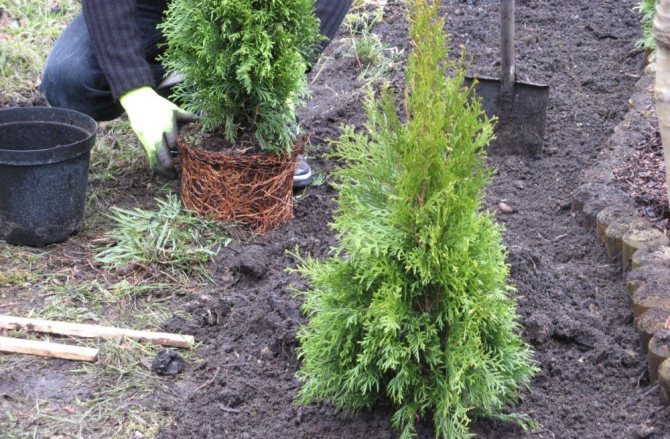

A few days before planting, it is necessary to prepare holes for seedlings up to 0.8 m deep and about 1 m in diameter.The soil obtained by digging planting holes is mixed with peat and sand (in a ratio of 2: 1: 1). Immediately before planting, nitroammophoska is added to this mixture (70 g per well).
Design ideas
Green hedge
If your dream is to get a solid green hedge, choose varieties such as Brabant, Kornik, Frieslandia, Yellow ribbon, Wagneri, Litomysl. They should be planted at a distance of at least 50 cm from each other, pruned tops so that the trees bush wide. The distance from the fence should be at least 1 m.
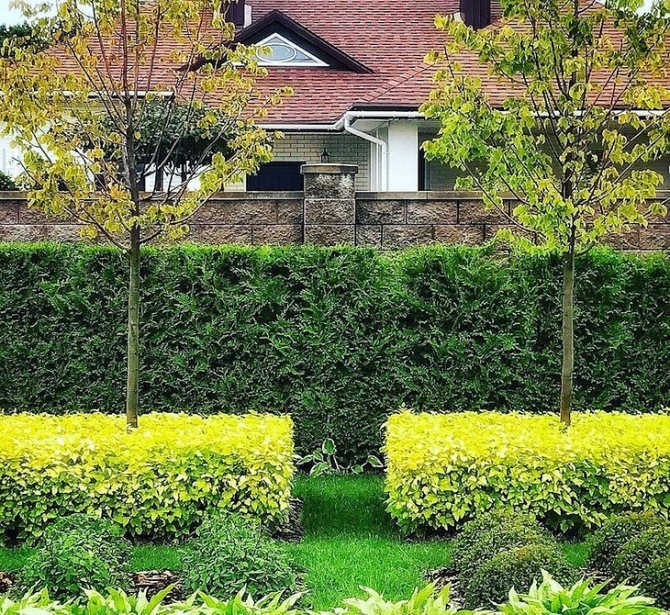

Instagram @ daria.familyhouse
Alpine slide
Tui are perfect for planting on an alpine slide. For this purpose it is better to use dwarf varieties Danica, Aurea Nana, Whipcord, Glauca Prostrata, Hoseri. They are unpretentious, do not require special care and frequent watering. The composition can be decorated with flowers - lavender, barberry, irises.
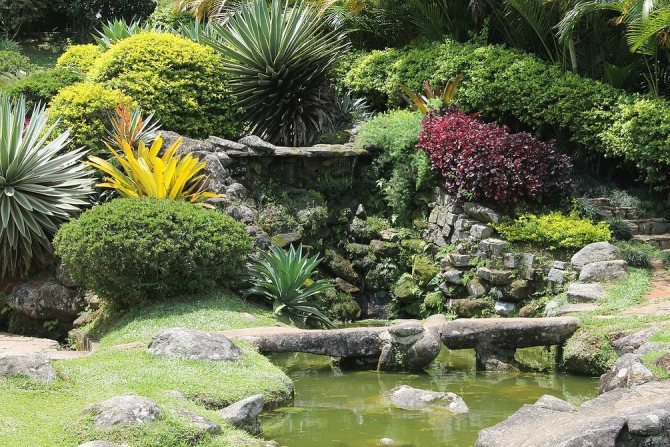

Pixabay
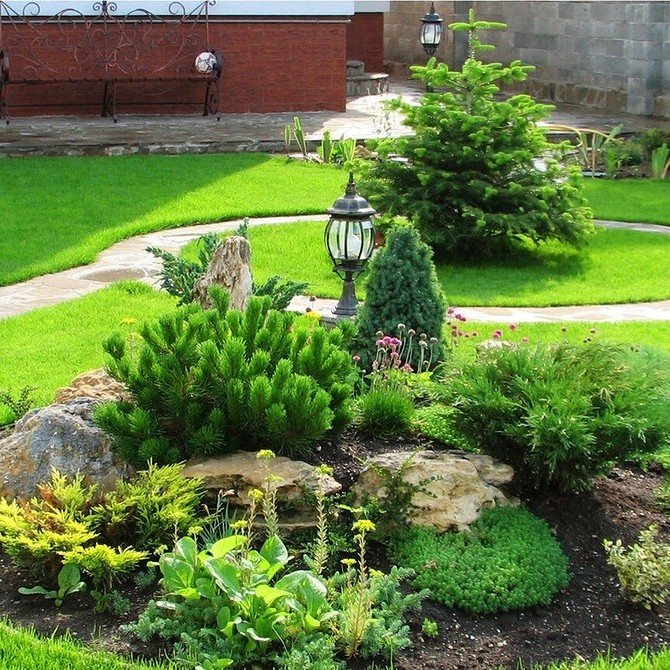

Instagram @ ldizain23
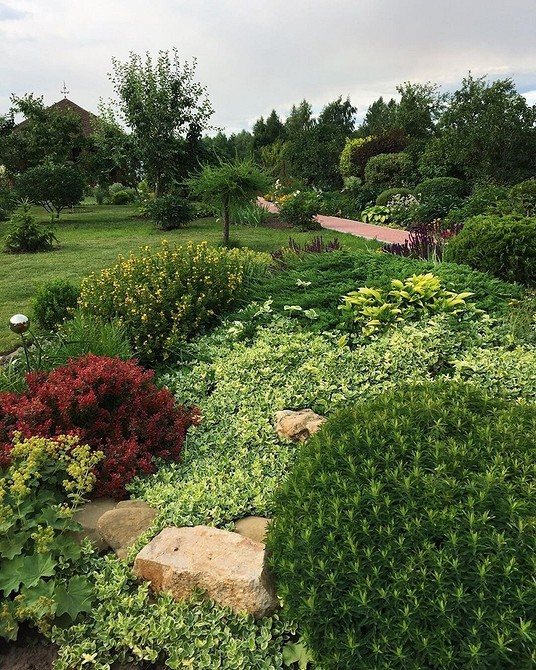

Instagram @vmoemsadu
Plant species
As already mentioned, thuja is divided into 6 types, which include more than 120 subspecies and varieties. Most of them can grow unhindered in our climate. Tuyu is widely used in landscape design to form beautiful flower beds and enclose a site with a lush hedge, as well as to decorate garden stones and other objects near a private house or commercial enterprise.
Consider the varieties of thuja most demanded by gardeners:
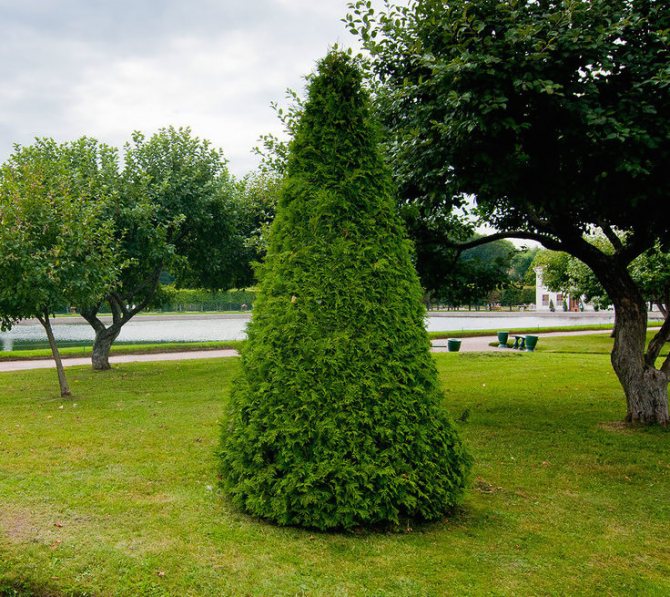

Western thuja tree
western (the most common type of ornamental plant, which can be seen not only on private land, but also in parks, squares and city alleys, its life span is measured in a millennium, a coniferous tree reaches 8-12 meters in height, the shape of a pyramid is characteristic of a young tree, but over time, it acquires an ovoid crown);
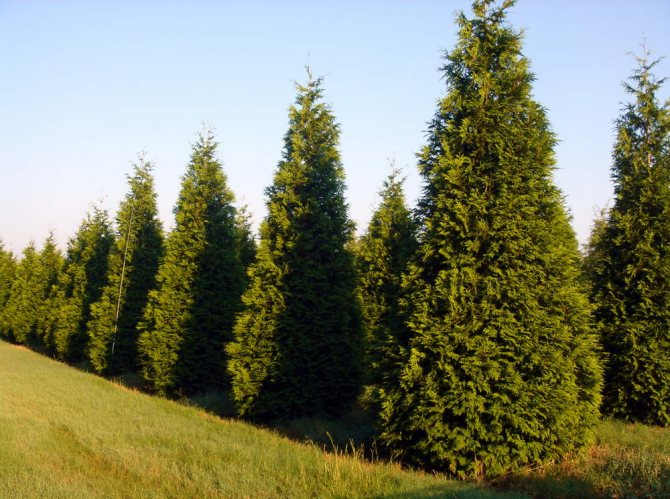

Fence of folded thuja
folded or giant (grows mainly on the Pacific coast, a very tall tree reaching 60 meters in height has a trunk diameter of 3 - 4 meters in volume, decorative varieties are shorter and less bulky, which allows them to be used in landscape design as a decoration for a park or alley);
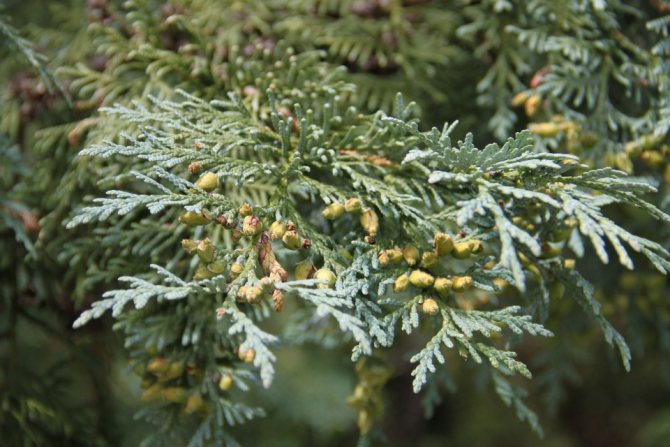

Korean thuja needles
korean (one of the shortest thujas, reaches a height of no more than 9 meters, in addition, it is characterized by low frost resistance, therefore, it requires the use of a covering material in the winter, has a beautiful needles with a whitish coating, casting silver);
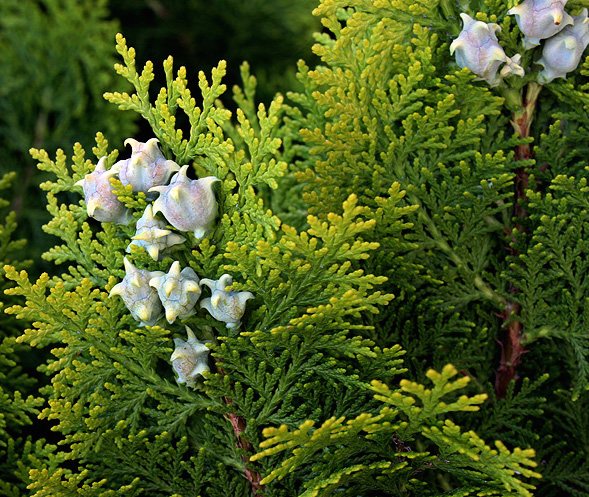

Japanese thuja cones
japanese (cone-shaped thuja, which in the wild reaches 18 meters in height, the bark is distinguished by a copper-red tint, and the lower branches have a silvery tint on a dark green background, for decorative purposes, shorter varieties of this breed are used, it is noteworthy that in a warm climate the plant grows much faster than in cold regions of the country);
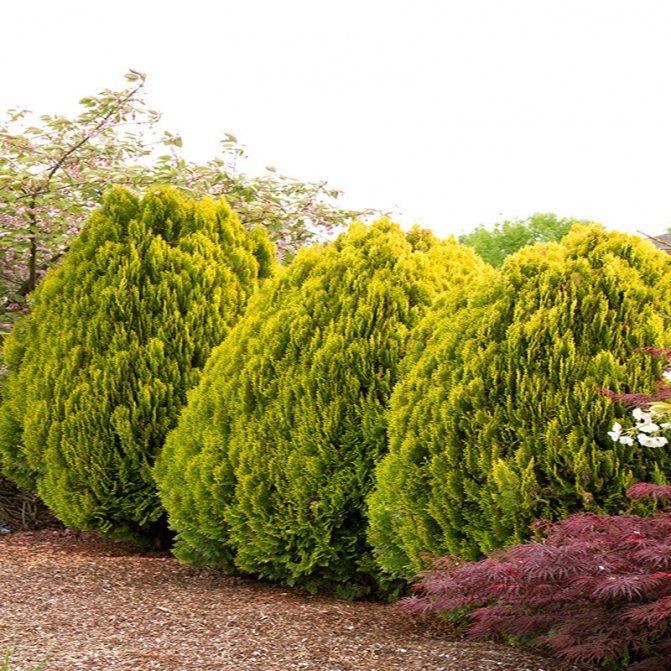

Eastern thuja bushes
oriental or flattened (in the wild it can be found in China and Central Asia, there are a large number of decorative species of this tree, they all differ in an openwork crown and a beautiful yellow-green hue, however, the plant is extremely unstable to frost, therefore, it requires careful care, especially preparation for the winter period) ...
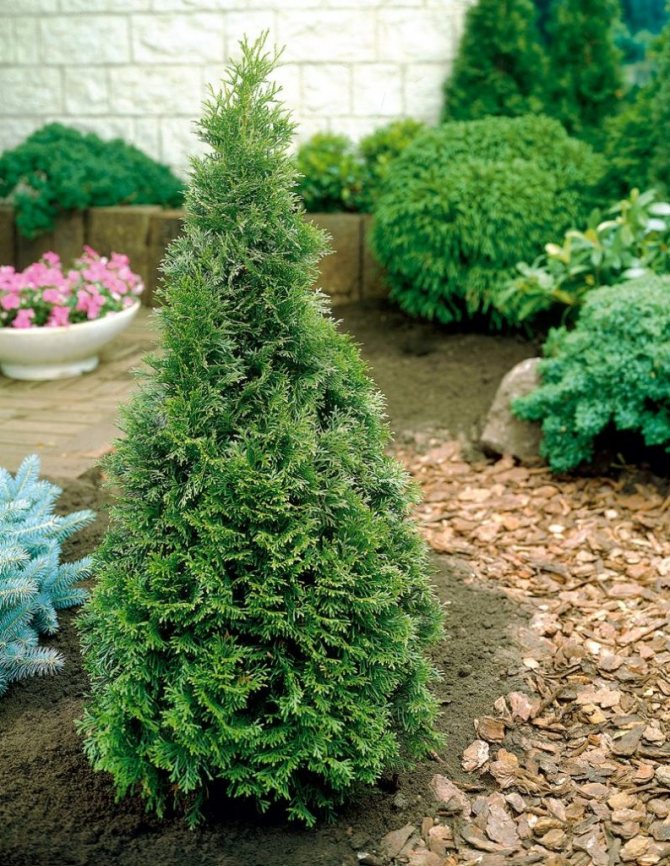

Thuja Smaragd tree
Thuya Smaragd - This is one of the most common ornamental varieties of the Western plant species. A small tree, not exceeding 2 meters in height, with vertical stems covered with a dark green crown. The tree is widely used in landscaping and gardening. The cone-shaped shape and evergreen dense branches give a beautiful plant on the site, which looks gorgeous as a decorative element in a private house or in a garden. It also looks great and organic as a decoration of squares and alleys in the city. Thuja Smaragd is a fairly frost-resistant plant that takes root well and does not require additional care in the open field.
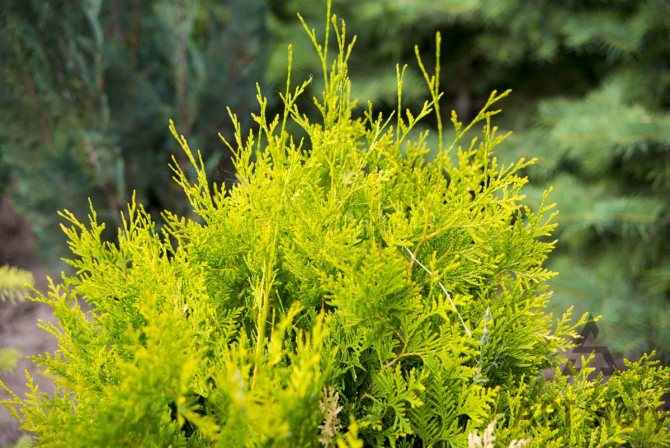

Thuja needles Brabant
Thuja Brabant Is another variety of the western plant variety popular with gardeners. Its height varies from 15 to 21 meters, the crown is dense and conical, the diameter of the main stem exceeds 3-4 meters. Scaly needles densely cover the numerous branches of the tree. Thuja Brabant is an excellent decoration for city parks and squares.
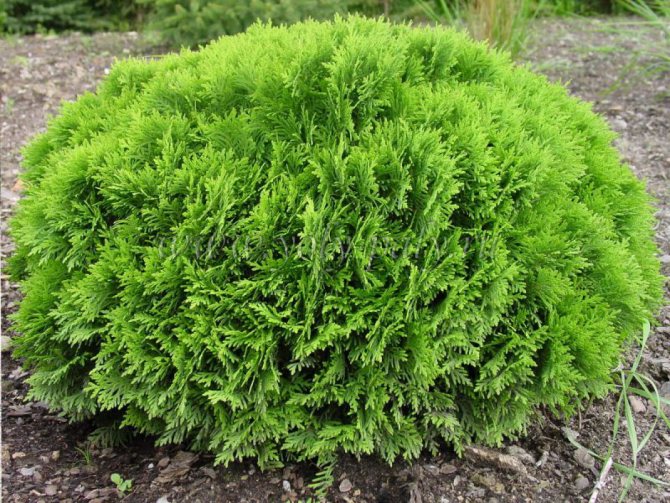

Thuja bush Danica
Tuya Danica - This is a spherical thuja, which is especially popular with gardeners. A low variety of ornamental tree, bred by breeders to decorate gardens and alleys. The crown, formed into a ball, is soft, scaly, characterized by a bright green tint with a silvery sheen. A feature of this species is the coloring of the crown in a light brown shade in winter.
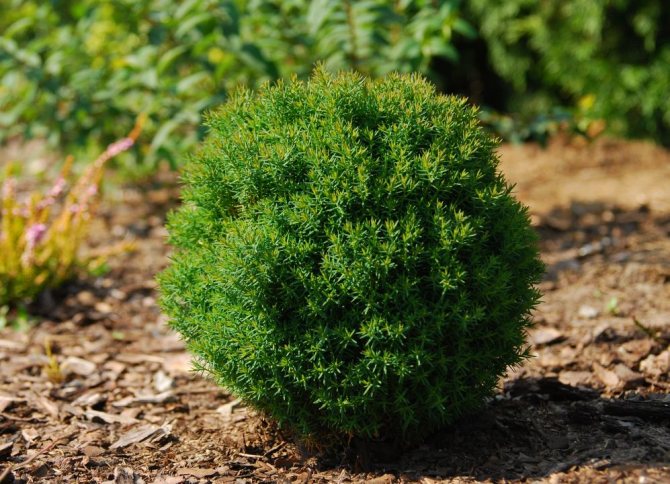

Thuja Teddy bush
Another unique variety of western thuja is thuja teddy... It is a dwarf plant in the shape of a regular ball. The variety was recently bred by breeders, but has already gained popularity among gardeners and landscape designers for its unique shape. Thuja Teddy is unpretentious in care and takes root well in various types of soils. In addition, it is a wonderful decoration for a personal plot, flower bed or city square. Its small size allows it to be used in rocky gardens and flower beds with tall shrub flowers.
How to choose the right seedling for planting?
In landscape design, many summer residents and owners of private houses use the coniferous beauty thuja. There are 3 traditional ways to reproduce it - by seeds, cuttings and seedlings. The latter is especially popular, since it does not require the application of significant efforts and work. But, for a start, you should competently approach the choice of the seedling itself.
There are several points to pay attention to when buying seedlings:
- sprouted cuttings can be purchased with an open root system (ACS), dug out of the ground, or closed (in a pot). It is better to buy them in specialized nurseries or stores, where experienced staff will help you choose the right variety and a healthy, strong tree that will be adapted to the local climate.
- you need to inspect the branches - they should not be dry and bend well
- you should touch the needles of the plant - on a healthy seedling it will hold firmly and will not crumble
- you need to carefully examine the tree - the presence of spots on the trunk or branches indicates a violation of the cultivation technology or a disease
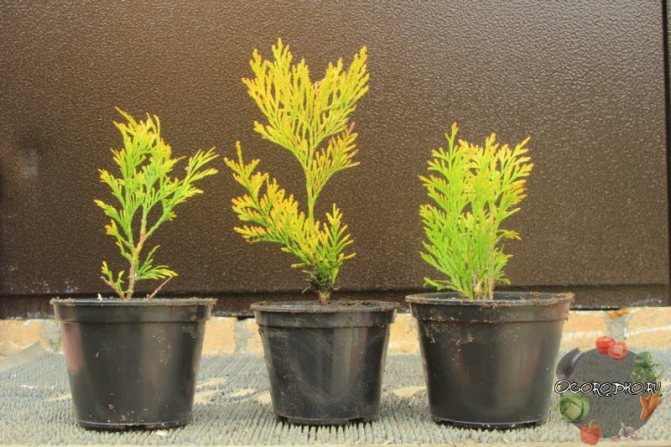

You can also purchase a small stalk, which should be grown first, and only then planted in the growing area. In addition, when buying, pay attention to the variety that should be suitable for the climatic growing conditions. For example, thuja western, whose varieties are diverse, looks great in landscape design and can be planted in different parts of our country.
Purchase of seedlings
Specialized garden shops and nurseries currently offer gardeners a huge selection of thuja seedlings of various varieties. You can choose trees of absolutely any age and size. It is best, of course, to buy small specimens, and then plant them in the country for growing. In most cases, there are no problems with this.
How to plant an apple tree correctly, and when is it better to do it
Planting young seedlings is preferable for the reason that they take root much faster in a new place, in contrast to already mature trees. If the gardener wants to arrange his summer cottage as soon as possible, then he will have to purchase an adult, developed plant. During the purchase, it is necessary to inspect the thuja well, with special attention to the following factors:
- How moist the soil is in the seedling container.
- How tightly the scales stick to the branches.
If the seedling is of good quality, then the branches will be strong, elastic, without any spots and signs of parasites or diseases. The needles in no case should crumble from young bushes. Having purchased it in a nursery or a store, it must be planted in the ground and watered as soon as possible.
If the root system of the seedling is open, then it should be placed in the soil in the spring, otherwise the tree will not take root. Those specimens that grow in containers can be planted on the site in summer.
Thuja features
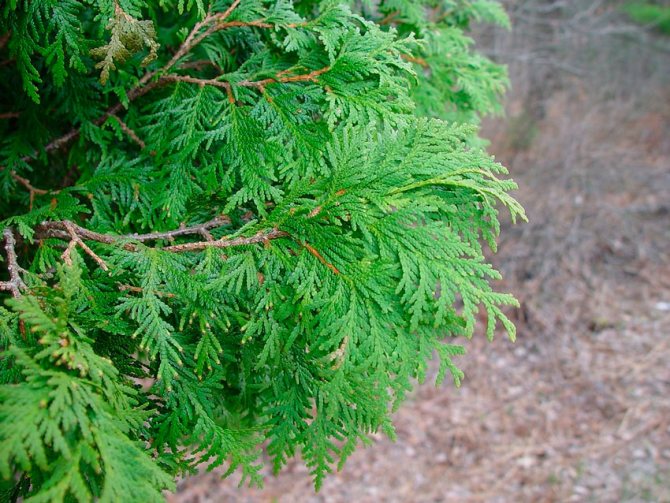

Thuja is represented by evergreen trees or shrubs. Under natural conditions, their trunk diameter can be equal to 6 meters, and the height - 70 meters. In horticulture, the height of this tree, as a rule, does not exceed 11 m. In young specimens, soft, needle-like needles have a pale green color. At the same time, in older specimens, the needles are scaly, oppositely opposite, and it has a dark green color. In such monoecious plants, the fruits are represented by small cones that have an oblong or oval shape, while their seeds are flat. Ripening of seeds occurs already in the first year. This plant is undemanding to care for and is resistant to cold and smoke. And western thuja is able to withstand frosty winters.
Thuja in the Urals, photo
Thuja pests
One of the pests of the plant is the thuja aphid - tiny insects that live in large colonies and look like white dust. If the thuja was attacked, then its needles will turn yellow and fall off.
To get rid of pests, cover the ground under the plant with cellophane and rinse the affected areas with soapy water. This should be done within 1-2 weeks.
A spider mite is especially dangerous for thuja, it cannot be confused with another pest, because it envelops the plant with cobwebs. As a result, the needles become covered with yellow spots and fall off.
You can cope with a spider mite by spraying the plant with infusion of garlic or dandelion. If the lesion is too large, then use acaricides. The tick does not like moisture, so it is worth spraying it with cold water.
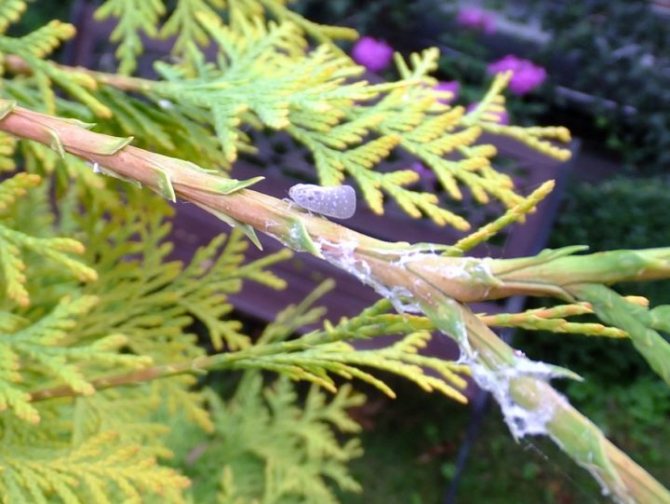

Tuya is waiting for treatment
The speckled moth gnaws thuja branches. If traces of this pest are seen, then it is better to cut off the affected branches. A completely affected plant must be treated with pyrethroid agents.
The leafworm makes spider cocoons by weaving thuja needles into them. The drugs Profi, Fufanon or Decis will help get rid of it.
Root click beetles feed on the roots of the tree. To remove them, you can use Zemlin, Trap or Bazudin.

